Report

You can view Bain's latest Global Private Equity Report here. The report below was published in February 2017.
Section 1. The private equity market in 2016: What happened?
Despite a slew of disruptive events that created volatile markets early in 2016, the private equity (PE) industry posted solid results for the year. With investors everywhere on the hunt for yield, private equity remains a favored asset for institutional investors who have the patience for longer-held bets. General partners (GPs) worked hard to keep their preferred status, finding and executing on good deals while rolling up their sleeves with portfolio companies to create value and successful exits.
Looking at the top-level metrics, the industry remained healthy in 2016, although some of the aggregate figures retreated from 2015 (see Figure 1.1). Exit activity was strong, but the totals for 2016 declined as deals that had been on hold during the global financial crisis and its immediate aftermath were finally digested. Fund-raising surged as limited partners (LPs) continued to recycle distributions into new capital commitments, working hard to maintain their targeted allocations of capital to this high-performing asset class. Returns had another strong showing, continuing to outperform public markets by a sizable gap over both short-term and long-term time horizons, thus reinforcing investor confidence. Global buyout activity, on the other hand, declined. Persistently high asset valuations and stiff competition from corporate buyers, complicated by macroeconomic and political uncertainties across regions, made deal making challenging in 2016.
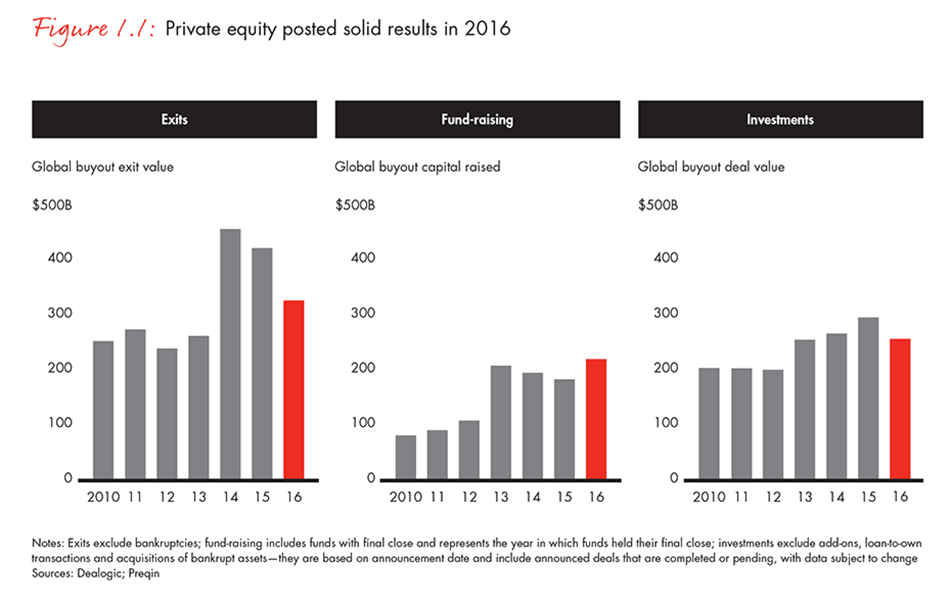

Exits: Back to a new normal
While not hosting quite the blowouts of 2014 and 2015, the PE industry wrapped up another strong year for exits in 2016. The remainder of deals that had been on hold during the global financial crisis and its immediate aftermath, and many deals invested since then, wound their way to daylight. Corporate buyers, flush with cash, remained willing to pay a premium for assets that would expand their reach or create synergy. PE firms and corporations were eager buyers during the year, offsetting the uncertainties of public markets that led to a stallout in initial public offerings (IPOs).
At first glance, the numbers show a decline: The aggregate value of buyout-backed exits globally dropped 23% in value and 19% in count from 2015, and even further from the record levels in 2014. But some perspective is helpful, as asset sales of $328 billion in disclosed value from 984 deals constitute an extremely strong run—indeed, by value, the industry experienced its fourth-best year ever (see Figure 1.2).
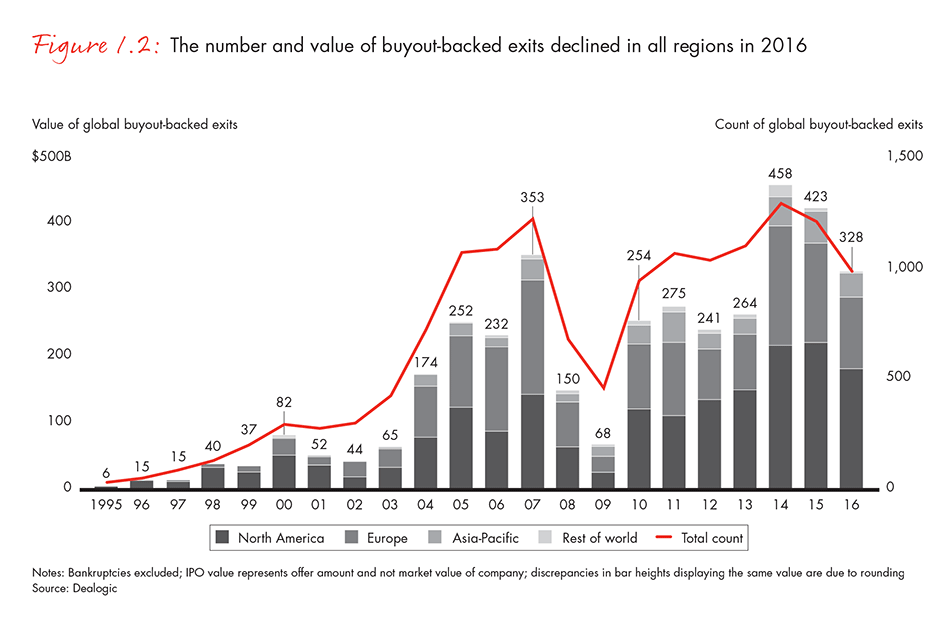

The level of exit activity varied by region. Leading the pack, the North American market had declines in buyout exit count and value of 17% and 18%, respectively, to reach $182 billion across 437 exits, while Europe and Asia-Pacific experienced steeper drops.
In the wake of regional turmoil around rising sovereign debts, bad bank loans, the surge of migrants and uncertainty about the path of Brexit, exit value in Europe was down 28% for the year, and exit count experienced a lesser 19% drop. As it became more difficult for investors to discern a fair price for assets, many deal processes stalled. Still, GPs in Europe pulled in $107 billion in asset sales equities. Looking at PE exits more broadly in the region, including sales of minority stakes in private companies and shares of publicly traded enterprises, the numbers were still down. Overall exit value came in at $74 billion in 2016, off 20% from 2015. Weak equity markets in the region made for a difficult IPO environment, causing Asia-Pacific IPO value to decline to $29 billion, off 24% from the 2011–2015 average, according to AVCJ.
Taking a longer view, the global decline in exits should not come as a surprise, given that exits flow from the deal pipeline of previous years, like a snake digesting an elephant’s worth of assets. The financial crisis paralyzed a huge backlog of deals invested from 2005 through 2008. Asset values took a severe hit for a few more years after that, and the stars began aligning for exits only around 2013. Since then, especially in 2014 and 2015, PE firms have used more favorable conditions to sell large inventories of unrealized assets acquired before the crisis. While there were some precrisis deals that found exits in 2016—US Foods, ConvaTec, Xella and Sun Products among them—these were among the last to be exited.
Today’s pipeline consists instead mainly of deals invested since the crisis. Very little capital—less than 10%—invested before the crisis remains in completely unrealized deals. The snake has finally digested most of its meal (see Figure 1.3).
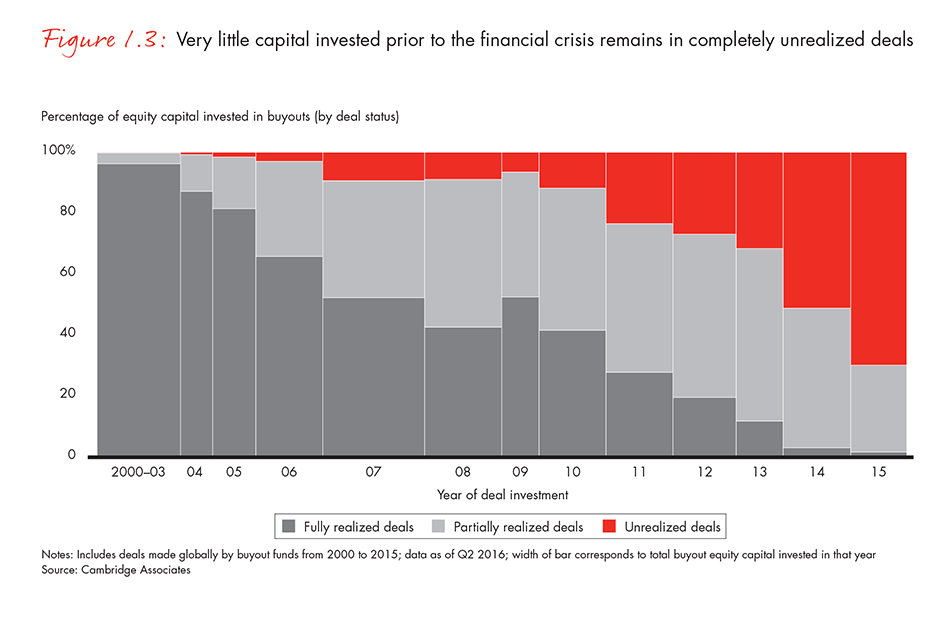

And that which does remain is not very nutritious: Nearly 70% of unrealized deals that were invested in 2008 or earlier are held by PE firms below par, according to global investment firm Cambridge Associates (see Figure 1.4).
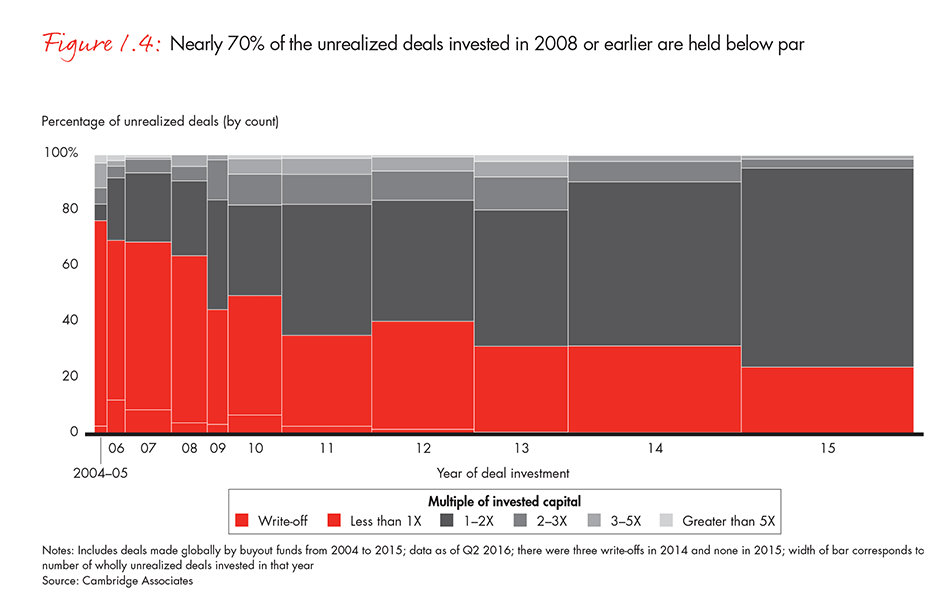

Longer holding periods settle in
Now that almost all of the precrisis deals have exited, the PE industry has established a new normal level for exits. Historically, PE firms held assets for three to five years on average. Median holding periods crept up steadily from 2008 to reach more than six years in 2014, as investments made during the precrisis boom years had to be held much longer than expected while PE firms managed them through the crisis and rehabilitated them through a slow recovery. Median holding periods have settled back to about five years for 2016, little changed from 2015 (see Figure 1.5).
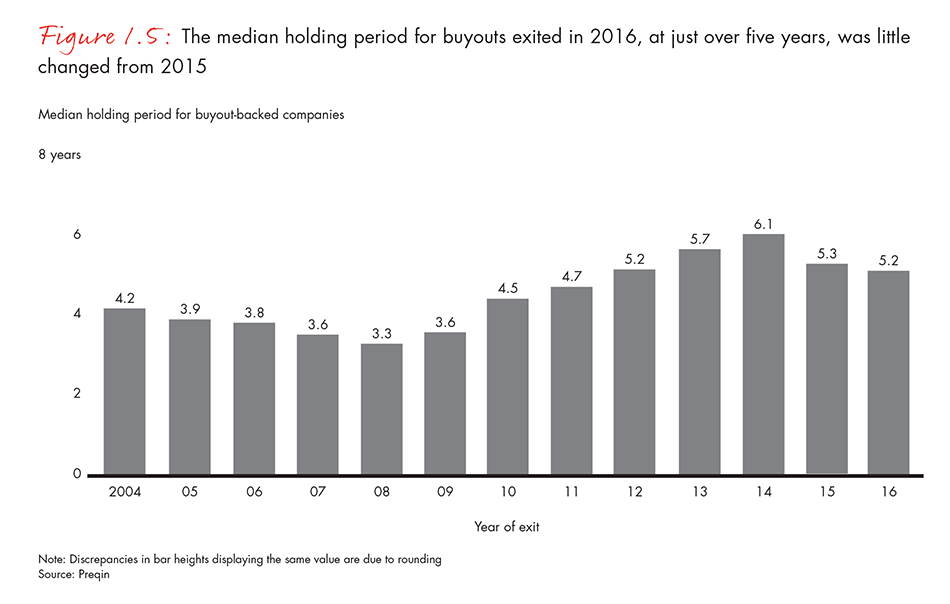

Longer holding periods likely will endure for at least the medium term. Assets currently in portfolios were bought at high prices, and with sources of market beta (such as multiple expansion and GDP growth) limited, GPs have to do the hard work of fixing or improving their assets. And that takes time.
Further evidence of longer holding periods can be found in the sharp drop-off of quick flips—deals held for less than three years. Quick flips comprised about 18% of all buyouts in 2016, a much smaller share than the 44% in 2008. The quick flips that closed during the past year often resulted from a strategic buyer—one who spotted an asset that would make a great fit when absorbed and was willing to pay a premium to obtain the asset right away. Take Blue Coat Systems, an enterprise security solutions company bought by Bain Capital in 2015 for $2.4 billion. Bain Capital filed for an IPO in June, but then Symantec agreed to buy Blue Coat for $4.65 billion after seeing value in combining Symantec’s threat-monitoring capabilities with Blue Coat’s network and cloud security offerings to protect customers across a range of technologies. Bain Capital reinvested $750 million in the combined company.
Finding the channel that fits
Exit conditions over the past four years showed notable signs of health, and those conditions continued in 2016. Funds with recent vintages have been tracking to distribute capital to LPs much faster than buyout funds that were caught in the financial crisis. This capital is flowing through several channels (see Figure 1.6).
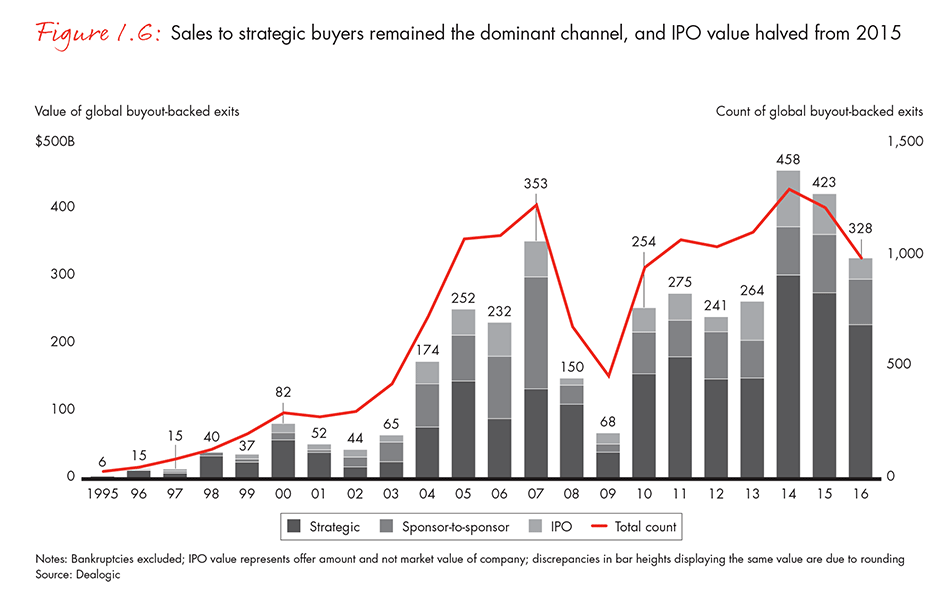

Sales to strategic acquirers. Cash-rich corporations accounted for the majority of buyout-backed exits in 2016, as they have done consistently since the financial crisis. Organic growth has been hard to come by for corporations, given the slow or flat economies in many countries. With plenty of cash on nonfinancial corporate balance sheets and activist investors urging executives to put it to good use, strategic acquirers have been shopping aggressively. They also have enlisted high equity valuations to serve as purchase currency. M&A remains a favored path to growth when corporate executives can find a strategic rationale or major synergies to extract. And these acquirers can afford to pay higher multiples than PE funds.
Globally, corporate M&A activity in 2016 slid 6% in count and 16% in value from the record value in 2015. In line with that trend, buyout-backed exits to strategic acquirers dropped by 17% in both count and value globally. The 10 largest exits to strategic buyers all occurred in the US and Western Europe, led by CVC Capital Partners with the top two deals: the sales of Formula One World Championship in the UK to Liberty Media for $7.9 billion and Spain’s IDCSalud Holding to Fresenius for $6.4 billion.
Public markets. For 2016, IPOs dropped 40% by count and 48% by value from 2015. Stock market volatility dampens IPO activity, so when political and economic uncertainty spiked in every region in the first quarter of 2016, most would-be IPOs withered on the vine. Buyout-backed IPO activity began picking up in the second quarter but never gained steady traction. Companies have increasingly been able to fuel their growth with private capital rather than tapping the public markets. And for sponsors seeking an exit, the certainty and speed of a sale to a strategic buyer or another financial sponsor often are more attractive than a public offering.
Nevertheless, some companies did get out of the gate in 2016. Among the largest buyout-backed IPOs in the US were Athene Holding, the insurer backed by Apollo, and US Foods, backed by KKR and Clayton, Dubilier & Rice (CD&R) after the Federal Trade Commission blocked the company’s sale to corporate acquirer Sysco. In Europe, large IPOs included medical technology company ConvaTec, owned by Nordic Capital and Avista Capital, and Nordic payments firm Nets, backed by a consortium of investors including Advent, Bain Capital and ATP Private Equity. The biggest IPO in 2016 was a Chinese company, ZTO Express, backed by Warburg Pincus, which skirted the large backlog of companies waiting for approval to go public on Chinese exchanges by making its debut on the New York Stock Exchange.
Sponsor-to-sponsor exits. The challenging IPO conditions and recession worries actually were a boon for the sponsor-to-sponsor channel. Absent a strategic buyer, many sellers chose the more certain, quicker gain of a sponsor-to-sponsor sale rather than roll the dice in public markets. For the past few years, dual-track processes have become more prevalent, with many GPs continuing to prepare IPOs for portfolio companies while simultaneously exploring an outright sale of the asset.
Several dual-track deals ended up on the sponsor-to-sponsor route, including inVentiv Health, Centennial Resource Development and Optiv Security. PE firms often acquire assets that don’t fill an obvious, immediate slot in a corporate buyer’s strategy or that need more renovation than a corporation wants to undertake.
Nine of the top 10 largest sponsor-to-sponsor deals took place in the US, led by MultiPlan, sold by Partners Group and Starr Investment Holdings to a consortium of Hellman & Friedman, Leonard Green and GIC for $7.5 billion.
A wealth of hidden exits
In addition to the three closely monitored exit channels discussed earlier, two other forms of exits garner less attention yet involve substantial amounts of capital: follow-on sales of shares in public companies and dividend recapitalizations.
Follow-on sales. A sizable stock of partially realized capital, much of it consisting of PE firms’ continuing stake in an asset they took to IPO, remains inside buyout funds. GPs hold these partial stakes because of legally mandated lockup periods following an IPO, because they anticipate that the value of the asset will rise or because they want to wait for better market conditions before fully unloading their stake.
The Carlyle Group, for example, acquired paint company Axalta Coating Systems in 2013 for $4.9 billion and took the company public in 2014. Carlyle then waited until 2016 to sell its remaining stake in two placements, reaping its second-largest profit ever on the deal.
Much of the capital invested before the financial crisis went toward public-to-private transactions. Because of the large size of many of these deals, the logical exit path was a return to public markets. Of the 20 biggest buyouts closed in 2006 or 2007, 12 went through the IPO portal. So although IPO activity was lighter in 2016, PE firms continued to sell down their stakes after previous IPOs. This flow of capital from follow-on sales does not get counted in exit value data, but it’s large. In 2016, follow-on sales of shares in buyout-backed companies totaled $79 billion globally, or roughly 2.5 times the buyout-backed IPO value (see Figure 1.7).
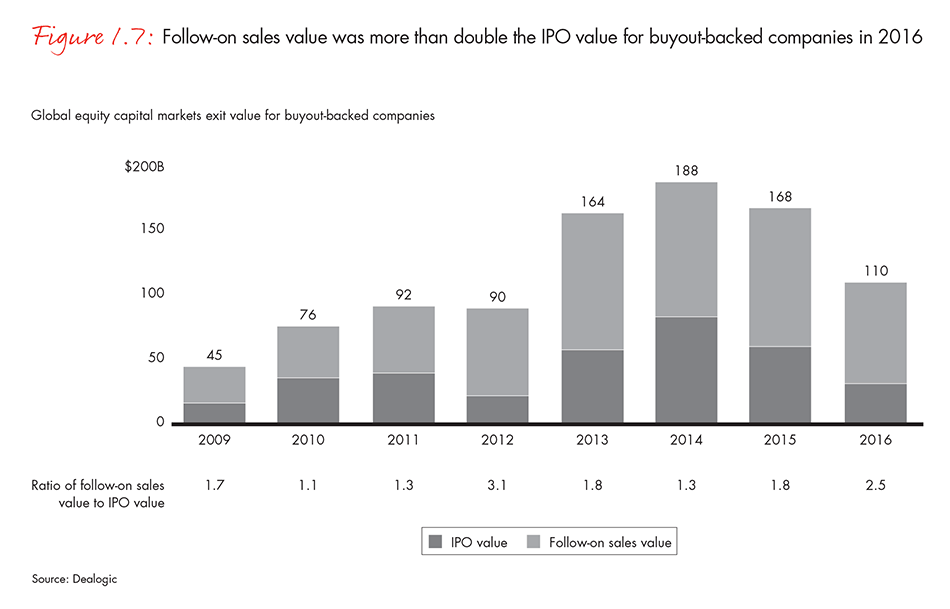

Dividend recaps. When a portfolio company takes on debt to fund a cash distribution to a PE sponsor or shareholders, it doesn’t count as an exit, but it does add to the flow of capital back to LPs. It’s a way for PE firms to reduce the risk of their investment—the trade-off being that they are increasing the risk of the underlying asset. The greater the investor appetite for debt paper, the more willing lenders are to undertake transactions that can weaken a company’s balance sheet.
Therefore, dividend recaps are an option to achieve liquidity that is highly dependent on market conditions. In 2016, PE firms aggressively took advantage of periods of strong creditor demand outpacing supply to execute dividend recaps. The year started off slowly in this regard, with lenders being “risk off,” waiting for markets to stabilize for a sustained period before declaring “risk on” in the second quarter, when the market rebounded.
For the year through September 20, PE funds extracted $7.1 billion of dividends via the loan market, down 31% from the same period in 2015, according to Leveraged Commentary & Data (LCD). On deals for which LCD tracked the original buyout, sponsors extracted an average of 78% of their original capital contribution through a recap, up slightly from 74% in 2015. Among the largest deals were McGraw-Hill Education’s dividend recap raising $400 million for Apollo investors and Sedgwick Claims Management Services taking on $325 million in debt to fund a dividend recap for sponsor KKR.
Fund-raising: As good as it gets
GPs that hit the road in 2016 to raise new funds continued to find healthy appetites among investors. In line with demand over the past several years, PE firms globally raised $589 billion in capital, just 2% less than in 2015 (see Figure 1.8). With more than $500 billion raised each year since 2013, it has been a banner period, with capital pouring into every PE sub-asset class. Taking this longer view reveals more than a single year would, because fund-raising data can be uneven since it is set based on the year of the final close of funds.
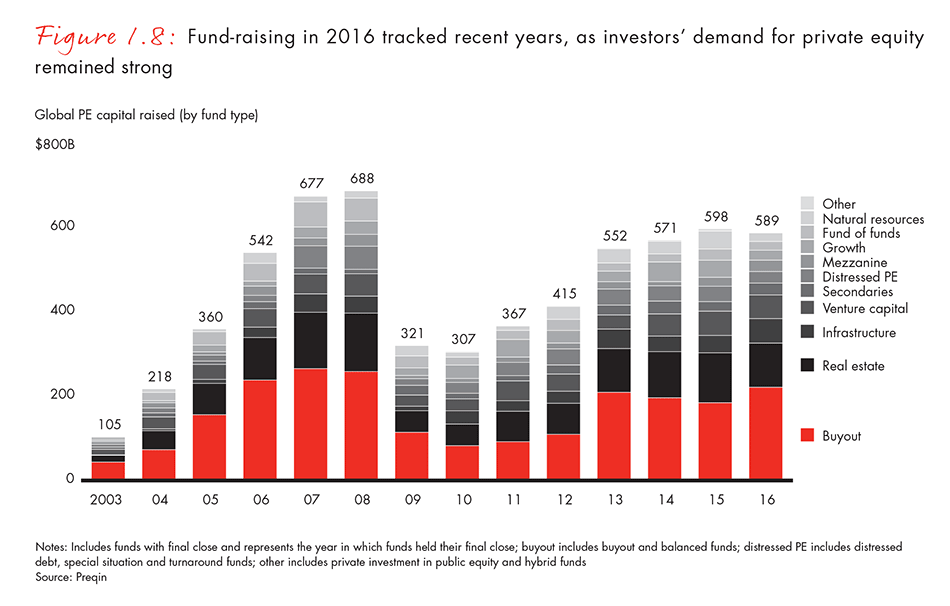

The industry has also seen substantial capital going into separately managed accounts. While not counted in total fund-raising data, separately managed accounts now comprise almost 6% of private capital raised, up from 2.5% in 2006.
Buyout funds had an even better year than the whole of private equity. Although there was a slight drop globally in the number of buyout funds reaching a final close—238 in 2016 compared with 269 in the previous year—these funds posted a 20% upswing in the amount of capital raised, rising to $221 billion.
One notable trend was the surge in megabuyout funds—those raising more than $5 billion—as 11 megafunds closed to raise $90 billion (see Figure 1.9). Investors broadly do not cite megafunds as the most attractive type of fund, but such funds hold great appeal to large institutional investors who want to put a massive amount of capital to work in the asset class. And LPs who want to contain the complexity of their holdings see them as a way to limit the number of funds and relationships they need to track and manage.
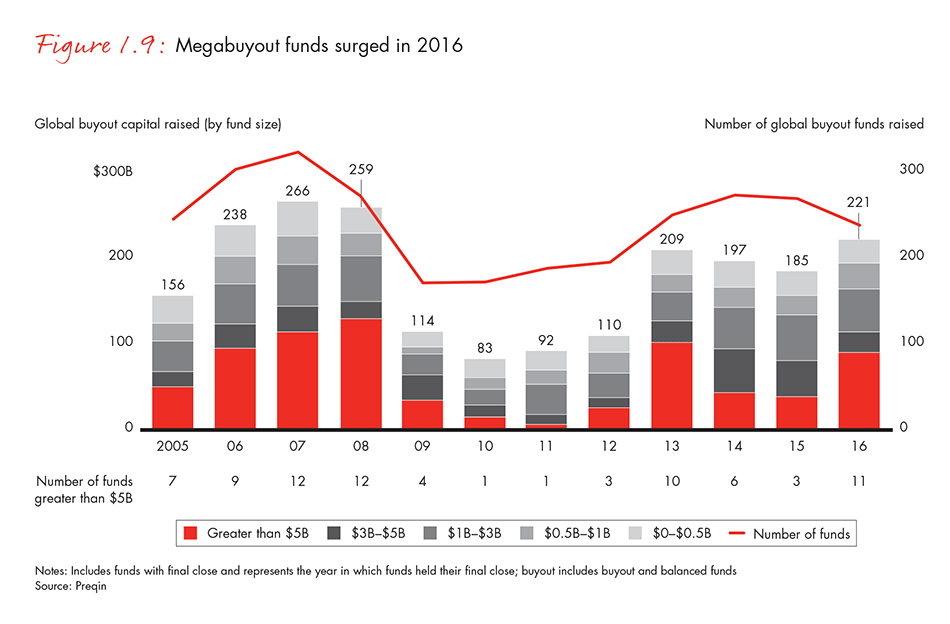

Indeed, in 2016 many top-performing, large buyout firms returned to the market to raise capital—and with great success. Advent set out to raise $12 billion, attracted more than $20 billion of interest and settled on $13 billion. Thoma Bravo closed at $7.6 billion, reaching its hard cap, and was significantly oversubscribed. Cinven reportedly reached its hard cap within four months and was oversubscribed by two times its target, settling on about $8 billion.
Beneath the strong global trend, a fair amount of regional variation characterized buyout fund-raising. Funds focused on North America experienced a slight uptick of 3%, to $106 billion. Those targeting buyouts in Western Europe showed no signs of slowing, with a 16% rise for the year, to $53 billion. Despite the succession of disruptive geopolitical events in Western Europe, many investors continue to believe in the region’s potential to generate strong future returns (see “Spotlight on Europe: Why the fractured continent still merits investment” on page 31). Buyout capital raised for investment in Asia-Pacific held fairly steady, with a pause in pan-Asia-Pacific funds largely offset by an increase in China-focused funds.
While funds can be classified by their primary geographic focus, many PE funds continue to loosen their investment mandates so that capital can be put to work across regions or even globally. This gives GPs a larger stomping ground and more flexibility should macro conditions deteriorate in any one region. And many PE firms continue to expand their geographic footprint accordingly. For example, UK investor Permira closed its Fund VI at almost $8 billion in 2016 and opened its first mainland China office in 2015.
In broad brush, then, the numbers bear out investors’ enduring affinity for private equity. Historically, private equity has ranked as the best-performing asset class, delivering an 8.3% median net internal rate of return (IRR) over the past decade for public pension funds vs. 5.3% for their total portfolio, according to alternative assets data provider Preqin. And in Preqin’s most recent survey of LPs, 95% of respondents said their PE investments have lived up to or exceeded expectations.
Investors struggle to reach their target allocations of private equity
Looking ahead, LP expectations for PE returns over the coming years have moderated. LPs recognize that a world awash in capital means that returns everywhere and for every asset class will continue to be bid down. Yet private equity is widely expected to continue to outperform other asset classes. Investors have been backing their beliefs with hard cash. The most recent Preqin survey found that 89% of LPs expect to commit the same or more capital to private equity over the next year as they did in the recent past. And 94% intend to maintain or increase their PE allocation over the longer term.
Why are LPs eager to plow capital back into private equity across every region? They are spurred by six years of strong cash distributions—the return of LPs’ original equity plus any gains. Globally, distributions exceeded contributions each year since 2011, with net cash flow turning positive and remaining so today. The ratio of distributions to contributions stood at 1.9 for the first half of 2016, meaning that for every $1 investors put to work, nearly $2 came back (see Figure 1.10). Because investors want to keep recycling their gains back into private equity, it’s no wonder the fund-raising environment has been so robust.
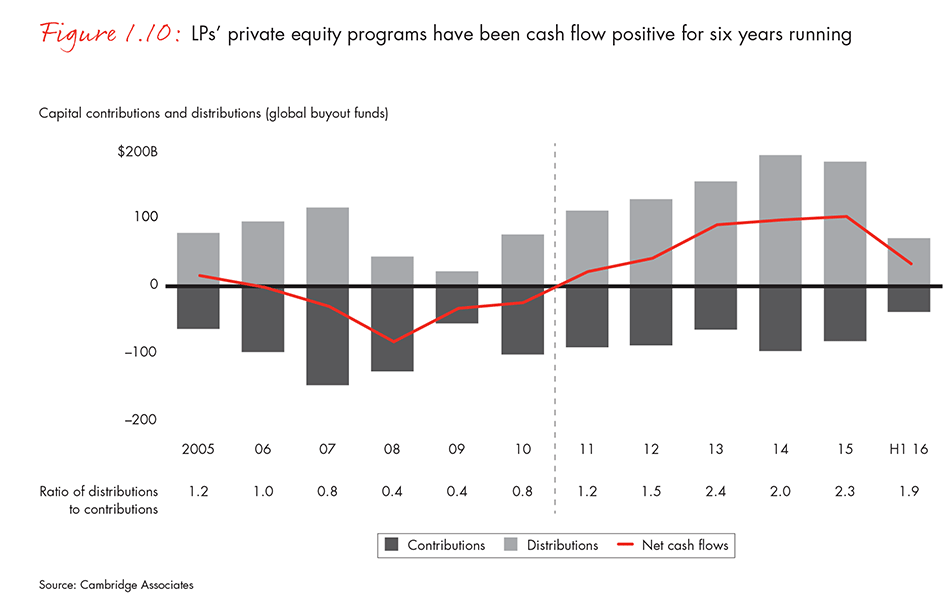

In fact, PE firms cannot quench investor demand. With LPs as a whole cash flow positive for a sixth consecutive year, it has become hard for many LPs to maintain their target PE allocations. The overall net asset value (NAV) for the buyout industry—the current valuation of all assets owned by buyout funds tracked by Cambridge Associates—declined over 2014 and 2015 to the start of 2016, from $696 billion to $610 billion (see Figure 1.11). The strong flow of distributions from robust exit conditions in each of these years has exceeded the combined capital put to work in new investments plus the increase in valuations of existing portfolio assets.
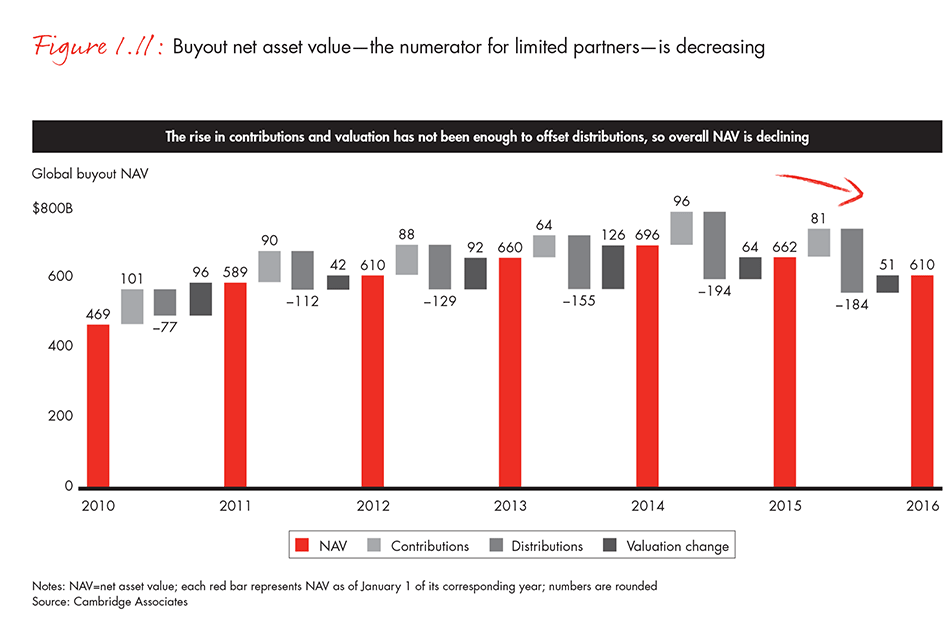

We highlight this trend because of the implications for LPs’ private equity allocations. NAV, the “numerator” for calculating current allocation to private equity, decreased. Meanwhile, assets under management, the “denominator,” increased for LPs after public equity markets in many geographies recovered from a rough start in 2016 to finish the year surprisingly well. As the numerator dropped and the denominator rose, many LPs ended the year below their target allocation of private equity. For example, Washington State Investment Board (WSIB), a well-regarded US pension fund, experienced a steady decline from a 26% actual allocation in mid-2012 to 21% in mid-2016. Over the same period, WSIB’s unfunded PE commitments rose from $8.2 billion to $12.7 billion.
These dynamics left headroom for LPs to maintain or increase the pace of their capital commitments to private equity, and they had plenty of funds from which to choose. More than 2,500 PE funds hit the road, looking to raise $890 billion at the start of 2016 across various types and geographies—and more funds joined them throughout the year, seeking to raise an additional $666 billion in capital. The fund-raising market remained crowded and competitive, as capital sought over the course of 2016 exceeded capital raised by 2.4 times. Among buyout funds, more than 300 went on the road, seeking $244 billion at the start of the year—and other funds joined during the year, seeking an additional $175 billion. For every $1 of capital in commitment, buyout funds sought some $2 (see Figure 1.12).
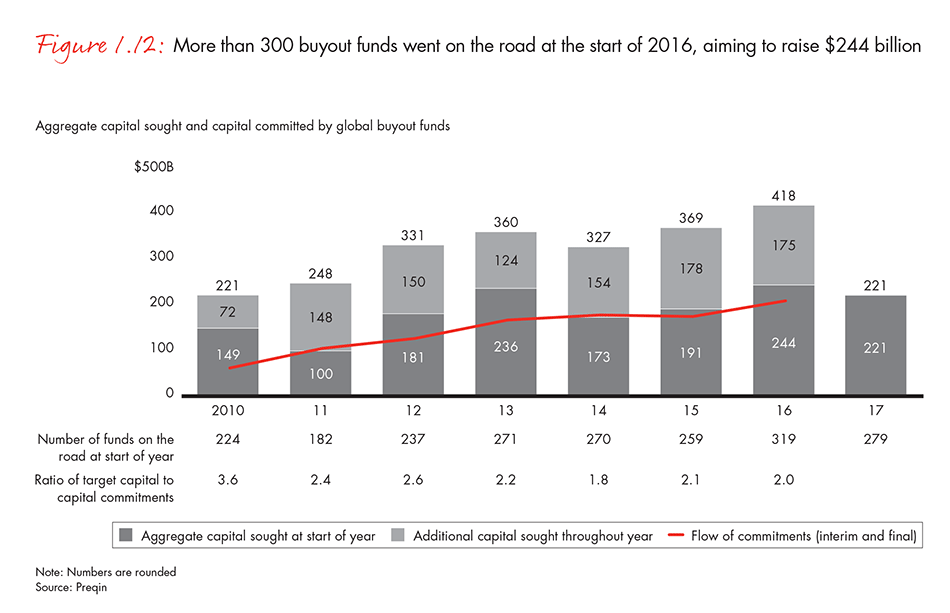

Despite the intense competition, strong demand allowed GPs to hit their fund-raising targets sooner in 2016 than in the prior year. Buyout funds were particularly successful, as 55% of funds that closed in 2016 took less than a year to raise their target level—or more. GPs welcomed the accelerated timetable. After all, fund-raising and meeting with prospective investors can take a lot of time.
Why fund-raising could get tougher
Many GPs are apprehensive that the industry cannot sustain the torrid pace of fund-raising much longer. A recession along with stagnant or falling stock markets could erode the denominator, possibly causing LPs to retrench. And distributions are expected to slow as the pipeline of exits shrinks. So even though we believe that distributions will continue to outpace contributions and that LP commitment to the PE asset class will stay strong, the fund-raising environment may not be as favorable in coming years.
GPs are making hay now while the sun shines, eager to secure capital commitments. Some are raising ever-larger funds. Vista Equity Partners, for example, is raising $10.5 billion for its Fund VI, up from the almost $6 billion for Fund V, which it closed on in 2014. Others are raising additional capital outside their main buyout fund series, through funds with a different geographic focus or in other sub-asset classes such as infrastructure or direct lending. Traditional buyout firms closed on $85 billion in capital raised outside of their flagship buyout fund series in 2016, and this type of fund-raising has had a compound annual growth rate (CAGR) of 10% since 2013.
High-performing GPs have been taking advantage of sterling market conditions to negotiate more favorable terms with LPs. Some have broken convention for hurdle rate, the minimum rate of return for a fund required before the manager begins taking carry. CVC reportedly plans a hurdle rate of 6% for its Fund VII, compared with the industry standard of 8%. Advent International removed the hurdle rate outright from its latest fund, which closed on $13 billion, though that decision was offset somewhat by the fund’s switch to the more LP-friendly European waterfall structure.
It’s another story for PE firms that don’t operate in the rarified upper atmosphere but instead have to duke it out in the middle of the pack. GPs are hurrying to raise capital now, before conditions take a turn for the worse and they risk getting scratched off investors’ lists for consideration. Almost half of LPs said that more than 10 fund pitches come over the transom to them each month, a Preqin survey found, and almost 40% of the respondents said that fewer than 5% of fund proposals made it past an initial review. In the battle for consideration by investors, established PE firm brands with strong, proven performance have a distinct advantage.
Perhaps the biggest lesson for PE firms in the realm of fund-raising after the financial crisis: Craft a very sharp articulation of your strategy for success. To that end, it helps to lay out a process as rigorous as (if narrower than) any process in due diligence or operational improvement.
For example, an infrastructure firm on the verge of launching its next fund-raising effort learned LPs worried that its strong returns entailed taking risks that were unusual for that sector. At the same time, market dynamics in the firm’s target sectors were changing, and the firm aspired to a larger size for its next fund—both of which might require redefining its deal sweet spot. Working with Bain, the firm developed a fund-raising strategy that would reaffirm its ability to generate exceptional returns with appropriate risk. The process relied on five components:
- Interviewing investors to understand how LPs perceive the firm relative to competitors, how they view the landscape for funds in this set, and what their risk and return expectations are.
- Profiling the risk and return performance of leading infrastructure investors to understand the firm’s position relative to key competitors.
- Assessing relevant risks, including the effect of commodity and macroeconomic swings on the portfolio, with a stress test of the largest positions.
- Reflecting on past investments to identify any threads of success that can help refine its deal sweet spot and differentiation. The firm also dissected past deal returns to show where and how the firm has added value as an owner.
- Distilling the fund strategy into a short, compelling narrative that shows prospective investors how the PE firm stands out from the rest of the pack.
From this process, the firm gained a clear understanding of what the target LPs sought in an infrastructure fund. With a sharply defined deal sweet spot and sources of differentiation at hand, the firm was able to crisply communicate how it could generate outsized returns, as well as its risk/return philosophy. The firm raised about 40% of its target capital within three months of launch and held a final close just over a year later, having raised significantly more than the target amount.
As it gets harder to find good deals at the right price and to generate great returns, PE firms that have pulled off that feat—and that are able to communicate succinctly how they use insights from past deals to generate great returns in the future—will have an edge in pulling in capital.
Investments: Good deals are getting harder to close
After a sharp drop in buyout deals following the global financial crisis, PE firms quickly landed a steady stream of new deals, with only minor year-to-year ups and downs. In 2016, global buyout activity lagged 2015 levels: The number of deals declined 18%, and value dropped by 14% (see Figure 1.13). Volatility in equity markets early in the year, caused by factors ranging from China’s stock bubble burst to a drop in oil prices to uncertainty in Europe regarding Brexit, dampened buyouts. And persistently high asset prices throughout the year inhibited deal making.
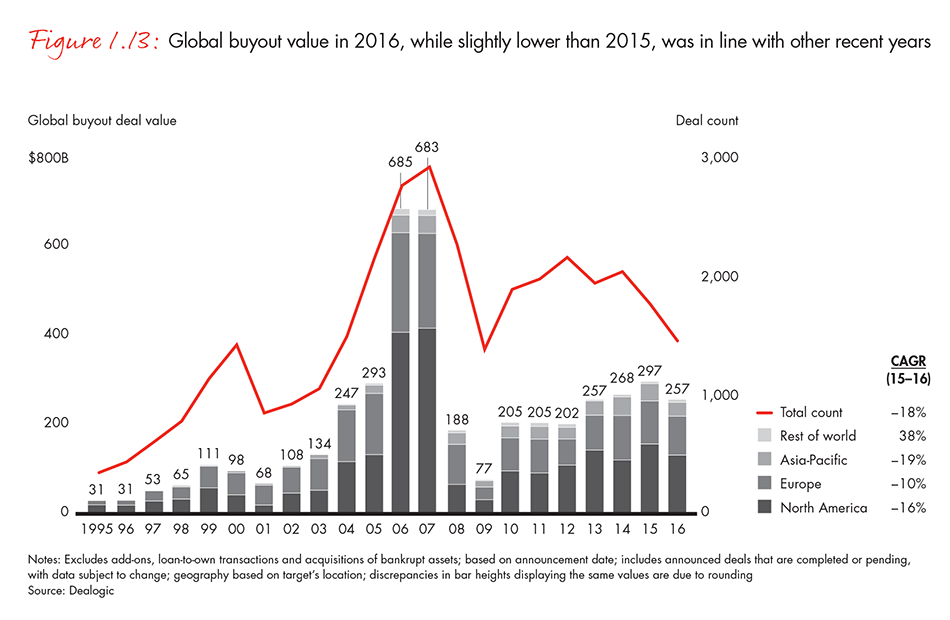

In North America, buyout activity never fully recovered from a slow first quarter, with the 2016 deal count down 24% and value down by 16%.
Europe saw a milder contraction, with the deal count down only 11% and value dropping 10%, a trend caused mainly by steeper declines in the UK. Despite being whipsawed by economic and political events, investors in Europe quickly got back to business after each flare-up.
Looking at Asia-Pacific’s PE investments more broadly than buyouts, the count slid 14%, and value declined 26%. It’s important to note, though, that these levels followed a record-high year in 2015. Also, the region had fewer deals above $1 billion, falling from a record-high count of 19 in 2015 to 12 such deals in 2016.
Simmering just under the surface: GPs grew even more frustrated with not finding and closing enough good deals. A recent Preqin survey of buyout GPs in late 2016 reported that 90% of respondents expect to deploy the same or more capital in PE investments in the coming year, yet almost 40% expect it will be more difficult to find attractive opportunities (see Figure 1.14).
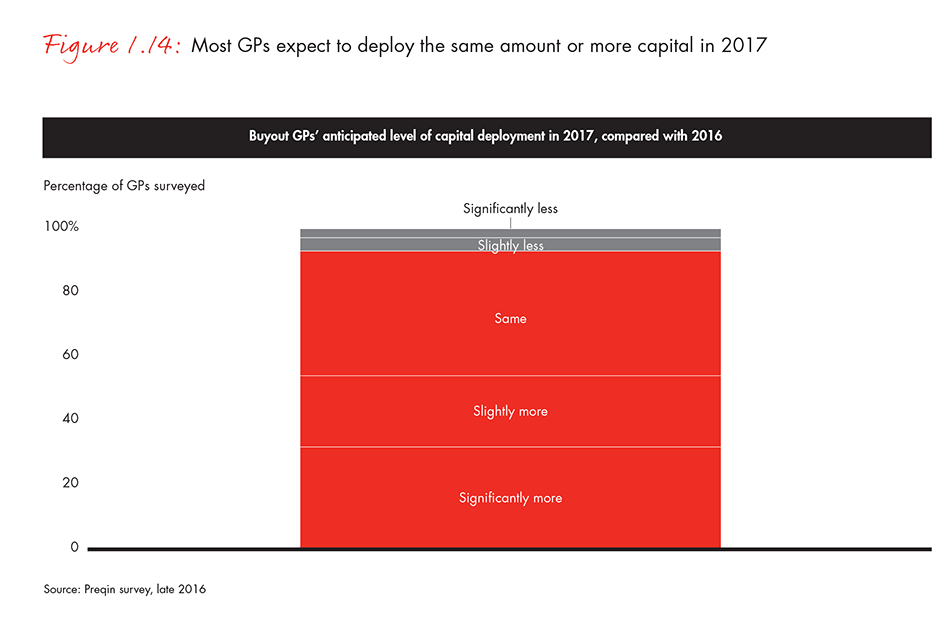

A brisk supply of assets …
Supply of assets is not the problem. A healthy number of assets—large and small—has been coming on line in a variety of flavors (see Figure 1.15).
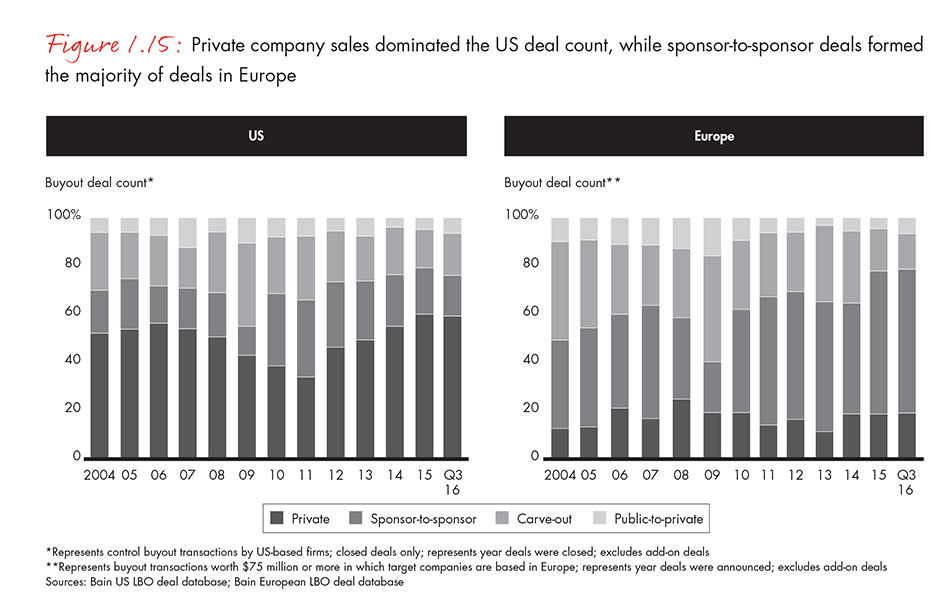

Public-to-private deals, for example, had a strong second half of 2016. The 10 largest public-to-private deals occurred in the US, led by Blackstone’s acquisition of Team Health Holdings for $6 billion and Apollo’s purchase of Rackspace Hosting for $4.4 billion. Seven of the top 10 came from the technology sector, where PE firms often see opportunities to apply an operational toolkit to improve management from a cost standpoint. Many GPs also favor tech companies for their revenue growth potential and relative resilience in recessions (see “Spotlight on the technology sector: Fundamentals, not fluff, still spur valuations” on page 27).
Sponsor-to-sponsor transactions continued to be a rich source of deals, with PE firms regularly scanning other firms’ portfolio companies for potential buyouts. A few of the largest deals in 2016 fit this category, such as Hellman & Friedman, Leonard Green and GIC buying MultiPlan for $7.5 billion, and KKR acquiring Epicor Software for $3.3 billion.
Private companies provided another strong source of deal flow, although the transactions tended to be smaller. In the US, about half of all buyouts by count in recent years have been acquisitions of private companies, and 2016 was no exception. Looking at disclosed value, though, they represented a much smaller slice of the pie.
Finally, carve-outs continued apace as corporations looked to take advantage of their high stock valuations by divesting noncore assets. Notable deals included GE’s divestiture of French consumer credit unit GE Money Bank to Cerberus Capital Management for $4.6 billion and Nissan Motors’ sale of its stake in Japanese automotive supplier Calsonic Kansei to KKR in a complex transaction structure.
… coincides with fierce demand …
GPs have demonstrated a demand for deals that’s even stronger than the closed deal data suggests. Underlying this demand are large stores of dry powder and cheap debt.
Committed but undeployed PE capital rose to a record level of $1.47 trillion in 2016. Of that amount, $534 billion was earmarked for buyouts—a 13% increase for the year and a 10% CAGR since 2012 (see Figure 1.16).
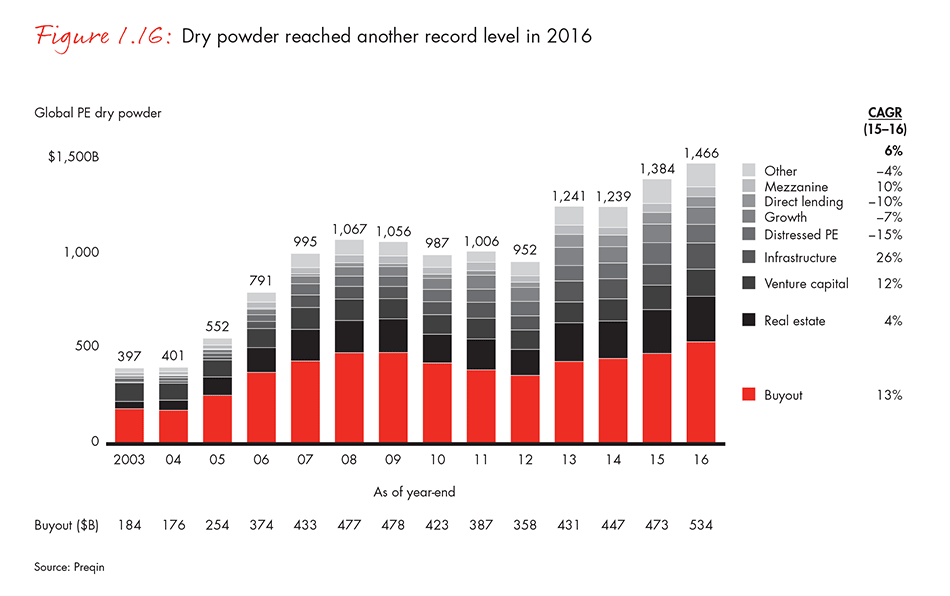

By year-end, PE firms in every region had refilled buyout coffers faster than they could put capital to work.
Looking inside the powder keg provides some measure of reassurance that, as in the past, the industry will find a home for LPs’ capital. At the end of 2016, fully 78% of dry powder was less than three years old. Moreover, just 8% was more than five years old—an amount in line with what would typically be held in reserve for add-on acquisitions or follow-on investments.
Investors found plenty of debt available to ride in tandem with their equity stakes. Particularly strong was the market for speculative debt, including leveraged buyouts (LBOs), motivated by the search for higher yield. Spreads on leveraged loans and high-yield bonds spiked early in the year but quickly returned to their new normal lows as markets stabilized. And as another sign of the hunt for yield, the majority of leveraged loans continued to be covenant lite. Limited restrictions on the debt-service capabilities of the borrower showed that plenty of investors were willing to trade away traditional debt protections in order to gain extra yield. In the US, multiples of debt to earnings before interest, taxes, depreciation and amortization (EBITDA) used to finance new buyouts have hovered north of five for several years, as lenders have been more than willing to accommodate PE investors (see Figure 1.17).
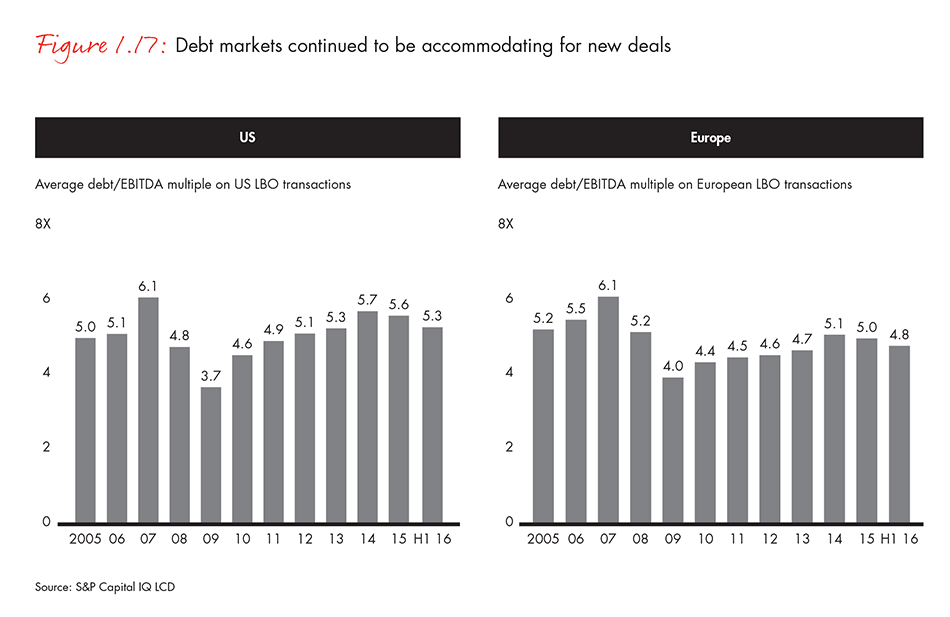

… but faces high prices and intense competition
With ample dry powder in the wings and debt readily available to ignite the powder, what makes crafting the deal so difficult? The crux of the problem lies in high and rising prices, combined with intense competition for assets—all at a time when the threat of recession looms larger and throws those prices into doubt.
Resilient PE markets have provided a floor on sellers’ price expectations. Acquisition multiples reached record or near-record highs across the US and Europe, at more than 10 times EBITDA in both regions at the start of 2016 (see Figure 1.18). In a recent Preqin survey, buyout GPs overwhelmingly cited deal pricing as the biggest challenge facing the industry.
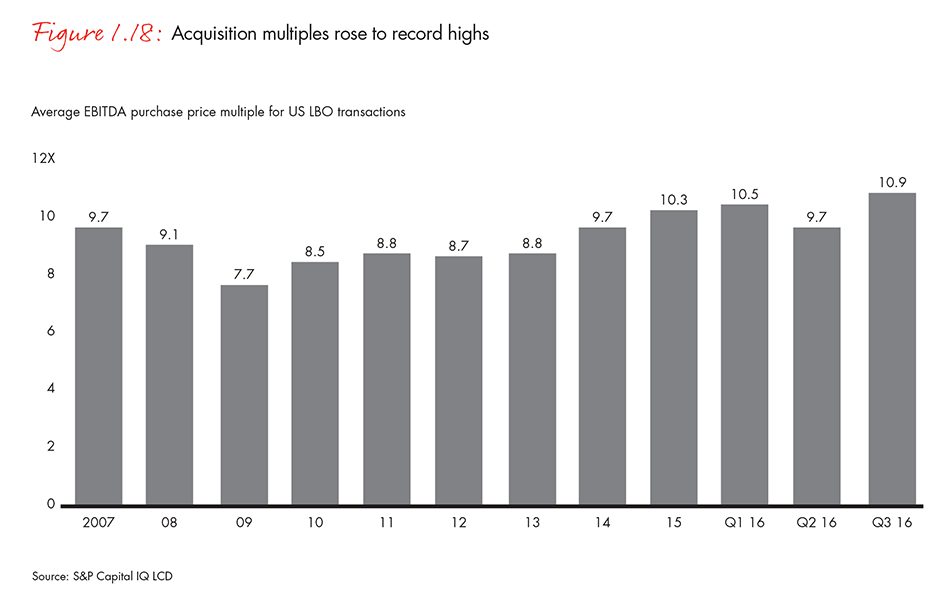

And there’s a new wrinkle: Every month brings us closer to what many consider an inevitable next recession. Assumptions that GPs now build into any deal model for market beta—future multiple expansion, GDP expansion, leverage—have turned more bearish. GPs find it increasingly difficult to pencil out how assets bought at prices today will achieve targeted returns.
GPs also face stiff competition from deep-pocketed strategic acquirers leading an M&A boom and LPs doing direct investments, with each group amplifying demand that keeps prices high. Corporate buyers have a different intent than GPs. At a time when organic growth is hard to come by, they are willing to pay higher multiples for assets they view as strategic or that will lead to synergies and help fuel growth. For example, Canon outbid KKR and Permira to buy Toshiba Medical Systems in 2016, paying close to $6 billion for a company generating an operating profit of $160 million. While the ranks of LPs investing directly on their own remain small, their lower cost of capital and subsequent ability to pay a higher price makes it difficult for PE firms to compete with them at auction.
Big deals can expand the market
An additional limiting factor on buyout deal value is the current lack of megadeals. While never common, megadeals have a substantial effect on the investment market when they do occur. Only two deals greater than $5 billion were announced in 2016—the buyouts of MultiPlan and Team Health mentioned earlier—and no deal above $10 billion was struck during the year. The majority of buyout deal value in 2016 came in the $1 billion–$5 billion range, with this segment rising 30% in value over 2015 (see Figure 1.19).
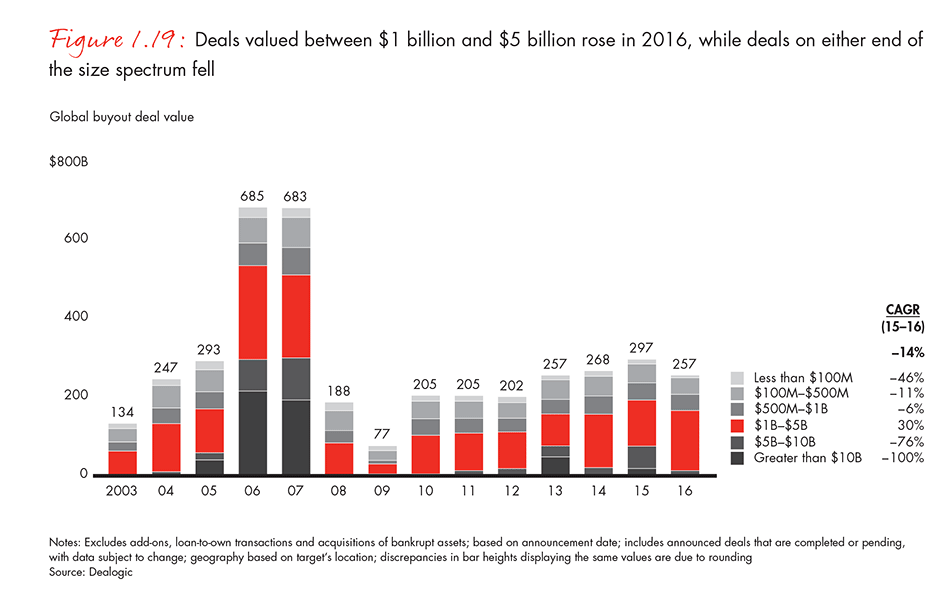

Consortium investing, which enabled many of the megadeals before the financial crisis, has fallen out of favor because of the complexities involved with comanaging owned assets. Most of the larger deals closed in 2016 consisted of coinvestments with strategic buyers and/or institutional investors, including Veritas Technologies, bought by Carlyle and GIC; Petco, acquired by CVC and the Canada Pension Plan Investment Board (CPPIB); and Keurig Green Mountain, bought by JAB Holdings, BDT Capital Partners and Mondelez International.
Looking ahead, it is an open question whether we will see more megadeals. Buyout fund sizes have increased, and the largest funds investing now have raised $18 billion in capital. Assuming one of these funds invests 15% of capital in one deal, layering in debt and adding in coinvestment from substantial LPs, deals greater than $10 billion are feasible without a consortium.
One hurdle potentially restricting the size of traditional buyouts is banks’ reluctance to finance big deals. Carlyle’s buyout of Veritas closed in January last year only after the terms of the deal were revised when lenders shelved the original debt package amidst deteriorating market conditions. Some investors have stepped in to fill gaps in lending. Goldman Sachs recently raised an $8 billion mezzanine fund that has already helped finance some of the largest buyouts closed in 2016. And with capital now pouring into the US leveraged loan market—a floating-rate asset class benefiting from the prospect of interest rate hikes—debt market conditions for financing new deals currently are favorable. But as the Veritas case illustrates, the debt market can be fickle, and big buyouts could be the first to be sidelined if lenders become more risk-averse.
The biggest buyout deals tend to be public-to-private conversions, which accounted for about 40% of the disclosed deal value of all US buyouts in 2016—a sum spread over 31 deals. Conditions could be ripe for more such transactions in the future. Buyout purchase price multiples and total enterprise-value-to-EBITDA multiples for US publicly traded companies have been converging in recent years.
At current prices, how many companies could potentially be attractive take-private targets? We stretched the bounds of feasible public-to-private deals to include any US publicly traded company with a total enterprise value up to $50 billion. We then applied a filter of a reasonable price to pay in order to achieve target returns given current leverage levels and terms, settling on less than nine times EBITDA. At that price, 794 companies fit the bill (remembering that taking a company private always involves paying a premium that must be factored into the multiple, often as much as 30% of the share price).
The prospect of almost 800 potential deals looks tantalizing. Yet the historical record suggests that a much lower level of take-private deals is realistic. Since 2010, PE firms have closed between 15 and 39 deals annually, with resulting values as low as $14 billion and as high as $71 billion (see Figure 1.20). The spike in 2013 can be explained by two creative deals, Heinz and Dell. On a base of around $250 billion in disclosed deal value, each additional take-private deal—especially a megadeal—has a significant impact on the market. And the upward trend in take-private activity from 2014 through 2016 could very well continue into 2017.
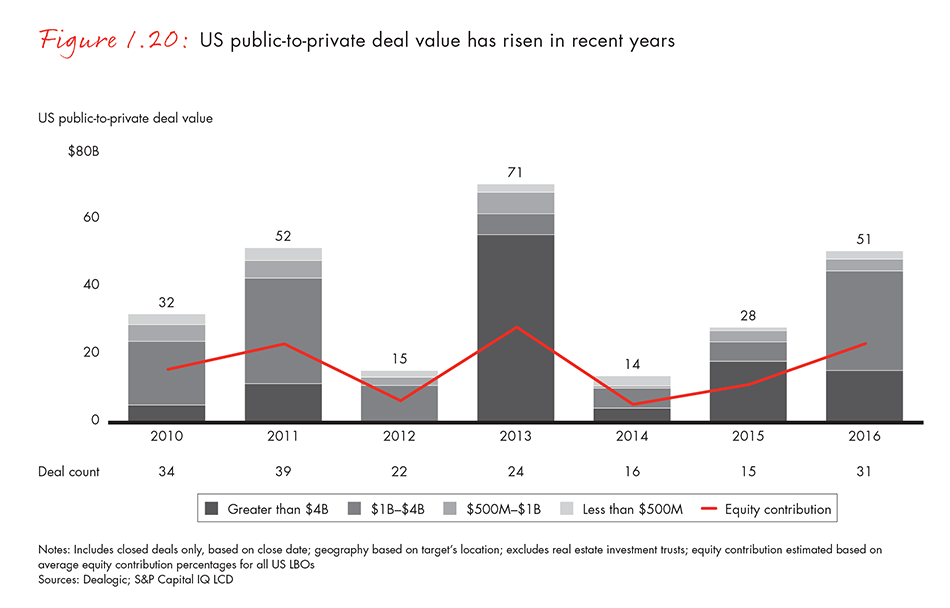

Returns: Private equity still outperforms
Once again, buyout funds globally delivered returns that beat public equity markets by a sizable margin in 2016. Using the modified public market equivalent (mPME), a metric developed by Cambridge Associates, it is possible to make an apples-to-apples comparison of PE returns with public equity returns by replicating the timing and size of PE cash flows as if they had been invested in public equities.
Every region saw outperformance by buyout funds. In the US, funds delivered a 6% end-to-end pooled IRR for the 12 months ending June 2016, compared with 4% for the S&P 500 using mPME. Buyout funds showed an even stronger performance in Europe over this same time horizon, with a 10% IRR, while the MSCI Europe, roiled by the Brexit vote, plunged 11%. Asia-Pacific’s combined buyout and growth funds rose a modest 2% but fared much better than the 9% decline of the MSCI All Country Asia Pacific; that decline largely stemmed from an overdue correction of the bubble in China’s stock market.
While heartening for LPs, short-term views have their limitations. Public markets can experience wide swings monthly or daily whereas PE assets, subject to mark-to-market accounting, go through more modest movements quarter to quarter. So while short-term returns capture the immediate dynamics of the recent past, they don’t offer a meaningful measurement of a long-term, illiquid asset class such as private equity.
As it happens, LPs had good reasons to cheer over longer time horizons as well (see Figure 1.21). The strong returns story over 10- and 20-year horizons reflects the solid valuation gains on funds’ portfolio holdings.
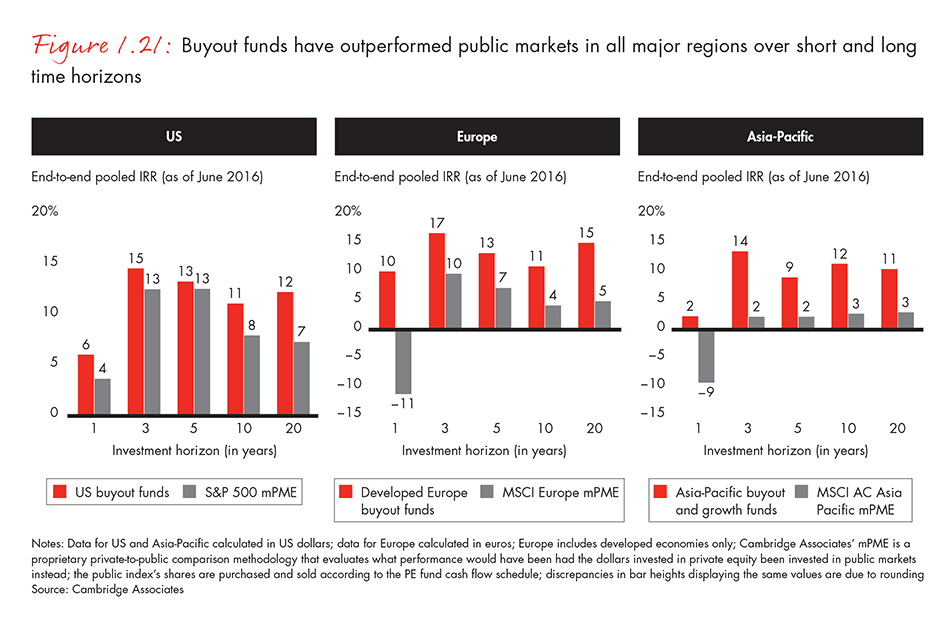

PE firms rely on repeatable strategies to source good deals and create value after the close, and they also manage a company’s balance sheet much more aggressively than their public company counterparts. Together, these disciplines produce returns that are consistently higher than public markets. The one-year buyout returns simply add to the longer story of sustained outperformance for the asset class.
How returns spreads have narrowed
One strand of the returns story bears watching: The spread between buyout returns and public markets—and within buyouts, the spread among fund performance quartiles—has narrowed in recent years. To understand why, let’s look at a few underlying trends.
Buyout returns have slowly trended downward. The PE industry has matured and become more competitive, with many more participants and massive amounts of capital competing for a limited set of deals. To be sure, superabundant capital has diluted returns across asset classes, not just private equity. Everyone is chasing yield, and where investors spot a sliver of extra yield, they pile in and bid down returns. Outsized returns that GPs could earn on once-common undervalued assets are harder to find today.
As such, the gap has tapered between the average performance of buyout funds and public equity markets. Over time, one would expect average PE returns to settle out at mPME plus an illiquidity premium. The best funds, though, will continue to outperform by a wide margin (see Figure 1.22).
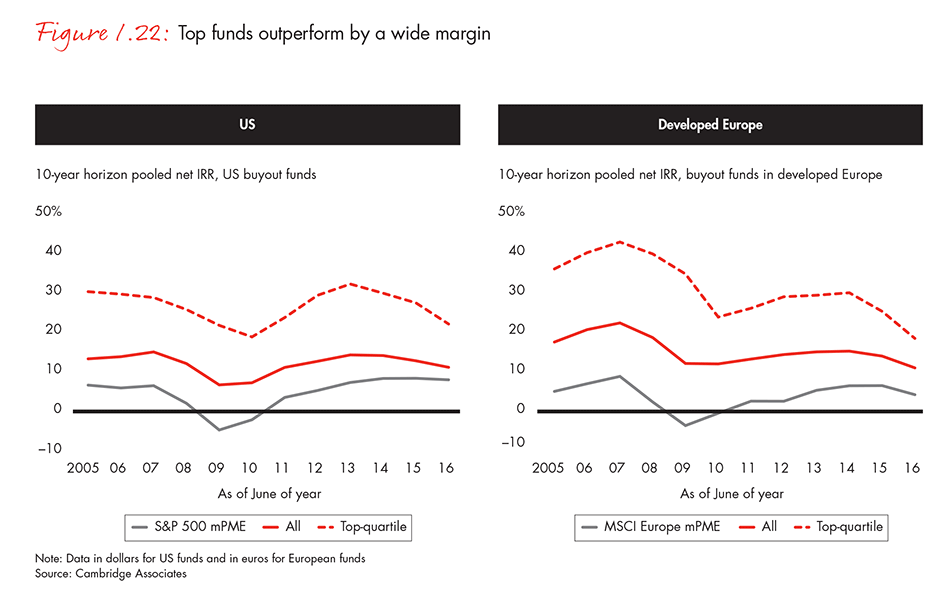

The spread of returns within buyouts also has converged recently. Here, the narrowing gap among fund quartiles likely is a short-term phenomenon rather than a long-term trend. Funds invested huge amounts of capital at high prices in 2006 and 2007. The financial crisis then dealt a major blow to asset valuations, and funds extended their holding periods. While many of the boom-time deals ended up fine, few ended up great. As a result, the spread of returns narrowed for these deals compared with investments made earlier in the decade, particularly when measured by IRR given the longer holding periods. This can be seen in Cambridge Associates’ analysis of PE deal-level returns, using its Private Investments Database of 27,000 portfolio company investments (see Figure 1.23).
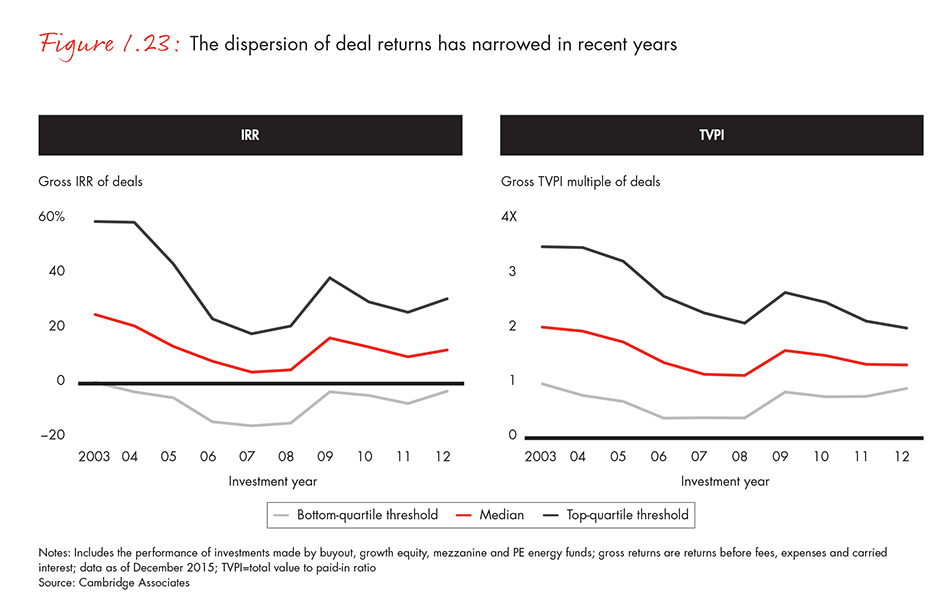

An additional factor contributing to the recent narrowing spread in returns is the relatively benign, consistent macroeconomic environment since 2010, which naturally limits the range of deal outcomes. Big winners and losers tend to emerge in periods of turbulence. Only when we see the next positive or negative jolt to the economy will return scenarios be amplified.
Top-quartile funds have fewer flops, more stars
So what accounts for top-quartile performance? Looking over the past three decades, top-quartile funds did two things differently.
First, they were able to contain the rates of capital impairment to much lower levels than other funds. Top-quartile funds had 20% of their deals experience capital impairment and an additional 6% of deals fully written off, about half the levels of bottom-quartile funds, according to Cambridge Associates (see Figure 1.24). Second, top-quartile funds made more winning deals than other funds. Top-quartile funds reaped more than five times the total value paid in on 13% of their deals, compared with just 2% of deals for bottom-quartile funds. Performance tends to persist in private equity, as the best firms can often repeat their success from one fund to the next.
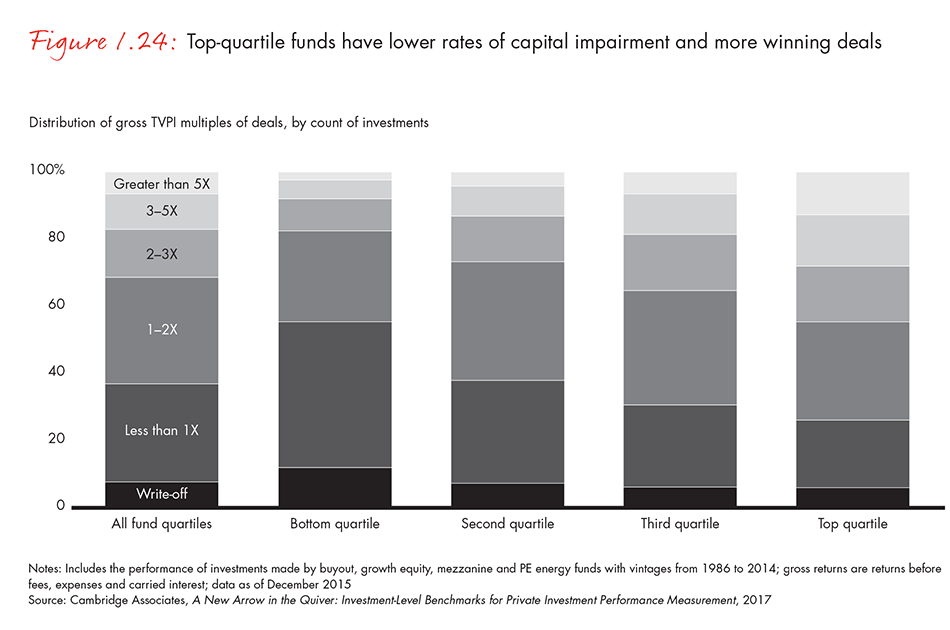

Breaking into the top quartile requires raising one’s game in several dimensions. Avoiding flops calls for excellent due diligence. Building star investments involves applying the insights from due diligence into a post-acquisition agenda, selectively taking on more risk and adding value over the holding period.
To satisfy their LPs’ expectations, GPs will have to continue to generate outsized returns. In Section 2, we examine some of the components for doing so, ranging from spotting a larger number of high-potential assets to devising a repeatable playbook for creating value.
Key takeaways
- At $328 billion, buyout-backed exit value declined from the heights of 2014 and 2015 but stood as the fourth-best year ever. The decline did not reflect a worsening exit environment but rather fewer assets in the pipeline ready for exit, as the industry has largely worked through the backlog of assets invested before the global financial crisis. Buyout firms have settled into a new normal, with median holding periods now at around five years.
- With LPs cash flow positive for six years in a row and staunchly committed to private equity, fund-raising continued unabated in 2016. LPs were eager to recycle gains into their best-performing asset class in an effort to maintain their target PE allocation. The $221 billion that GPs attracted for commitments in new buyout funds came in 20% above the amount raised in 2015, with a surge in megafunds. Across all fund types, PE firms globally raised $589 billion, just 2% less than in 2015. Firms raised their target amounts and closed faster than ever, with buyout funds being particularly successful.
- On the investment front, global buyout deal value totaled $257 billion—a level in line with the past few years—as buyout dry powder increased to a record $534 billion and the debt market remained accommodating. Buyout purchase price multiples set a new record, rising above 10 times EBITDA on average in the US and Europe. High prices and stiff competition, in particular from corporate buyers, made it tougher for PE firms to do deals.
- Buyout returns continued to outperform public market benchmarks over both short- and long-term time horizons and across regions. In recent years, the gap between buyout returns and public markets—and within the buyout industry between top- and bottom-quartile fund performance—has narrowed. This narrowing stems largely from two factors: the lower dispersion in returns for deals invested before the financial crisis and benign economic conditions since the crisis naturally limiting the range of deal outcomes.
Spotlight on the technology sector: Fundamentals, not fluff, still spur valuations
PE investors have eagerly plowed capital into the technology sector in recent years. Since 2010, they have closed 120 to 170 deals globally each year, and 4 of the 10 largest leveraged buyouts have been tech companies: Dell, BMC Software, Veritas Technologies and Solera Holdings.
Average purchase price multiples for tech deals exceed multiples in most other sectors. We compared the five largest software public-to-private deals closed during 2015 and 2016 with the five largest nontech deals. The average price-to-EBITDA multiple for the software deals was 18.1 vs. 10.2 for the nontech deals, and the high prices being paid may lead some investors to question whether the sector has overheated.
To be sure, investors must choose their tech targets carefully and think through which operational toolkit they will use to realize adequate returns. Yet there is convincing evidence that the current levels of deal activity and prices are supported by underlying business fundamentals. Levels of deal activity, both count and value, have not reached historical highs.
Moreover, a simple comparison of multiples misses some good reasons why tech deals trade at a premium. Tech-focused companies tend to generate stronger revenue growth. Over the five years preceding acquisition, the five largest software public-to-private deals in 2015 and 2016 had average annual revenue growth of 22.6% vs. just 5.7% for the nontech deals. And none of the software companies had declining revenues in any year, whereas one of the nontech companies did. Looking only at EBITDA multiples misses the reinvestments being made to produce such revenue growth. Tech assets also typically deliver high free cash flow conversion, particularly in software and tech-enabled services, which account for roughly 80% of technology deals by count and value (see Figure 1.25).
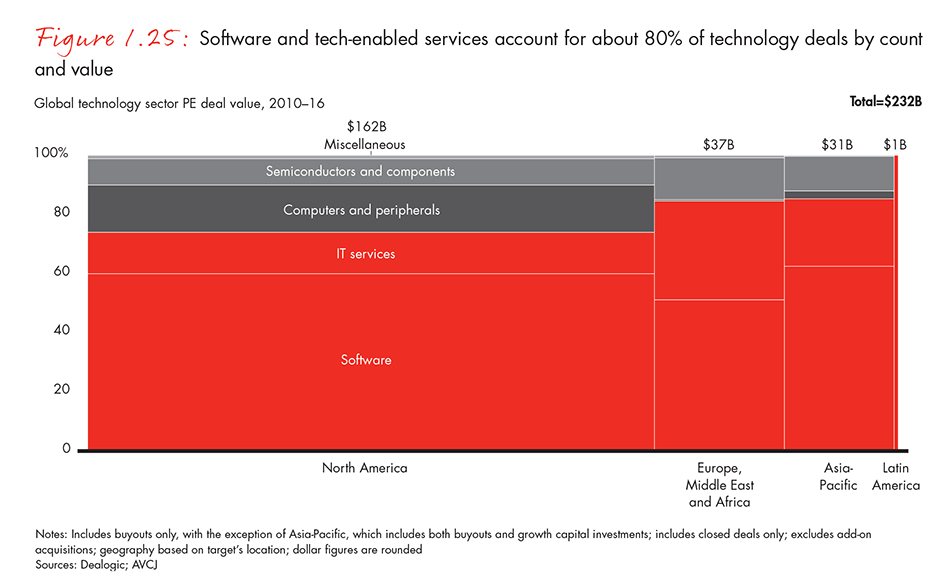

Providers in these industries enjoy ample and recession-resistant recurring revenue streams, as customers often view their products as critical systems that are used daily in their core businesses. Many software providers also benefit from strong customer loyalty: Business leaders view them as a small part of their overall cost base and are reluctant to go through the expense, pain and risk of implementing new systems and retraining employees. That creates both customer stability and an opportunity for software vendors to raise their prices for additional value delivered over time. And many enterprise applications are still penetrating their markets, so there is room for new customer growth.
Recession resistance figures into valuation multiples as well. The premium on technology’s valuations rose in recent years as the economic cycle grew long in the tooth and GPs sought assets that could be safely leveraged in the event of a recession.
Finally, in many software markets, two or three firms have clear leads, benefiting from a virtuous cycle of reinvestment in an industry in which adding customers often entails near-zero cost of goods sold. Established market leaders frequently can buy smaller competitors at a discount valuation, eventually migrating the customers to their own platforms and incorporating any useful technology. Given the asset-light nature of software, investors often realize significant cost synergies when they combine the departments of two companies.
These strong business fundamentals stand in contrast to the speculative thinking and fluff of the dotcom bubble, or an earlier period when tech deals included buyouts of capex-heavy businesses in subsectors such as semiconductors and were made at the wrong point in the cycle. Recent tech deals have outperformed those in many other industries. Return multiples for software deals have been higher, and fewer deals have suffered from capital impairment, according to CEPRES, a provider of products and services that support PE investment decisions (see Figure 1.26).
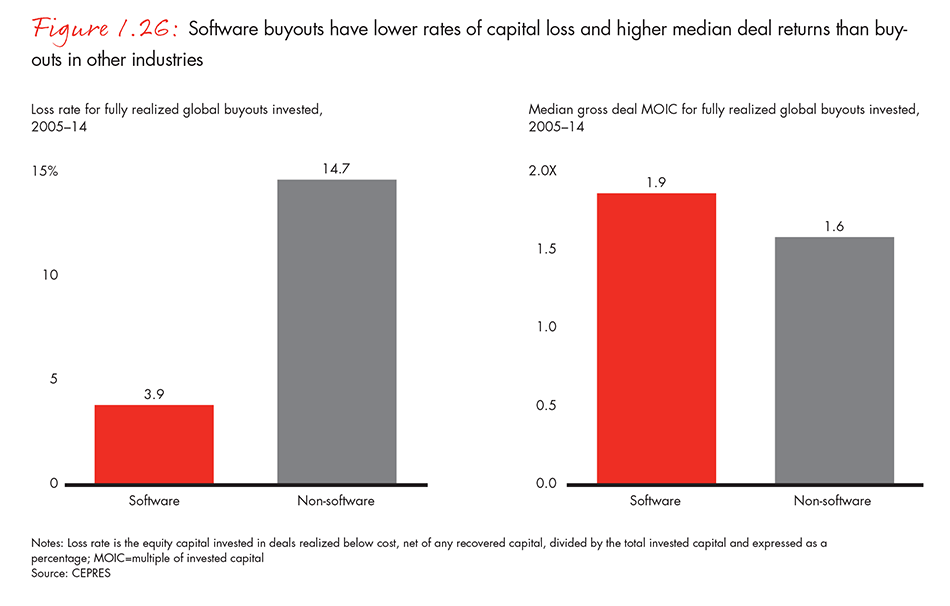

Looking ahead, the tech sector appears to be well positioned for the long haul. More and more corporate spending is devoted to IT and digital projects. Technology, particularly software and analytics, increasingly underpins profitability and growth, and helps companies manage risk in businesses throughout the economy. Indeed, many of the largest deals in other sectors, including MultiPlan and IMS Health, rely heavily on technology.
Illuminating the blind spots and the hidden gems
Despite the past success of many tech companies—or perhaps because of it—investors often find untapped opportunities for operational improvements. Successful software businesses often are so profitable that management teams may not aggressively optimize costs, operating efficiencies or revenue models. This leaves room for experienced investors to step in, restructure or refine, and improve performance.
One rule of thumb used by experienced tech investors as a preliminary asset screen is the “rule of 40,” which says that software businesses should have organic revenue growth plus EBITDA margins of 40% or higher. A company much lower than 40 is probably investing too much relative to the profits it takes out. (By contrast, a company that far exceeds 40 may not be investing enough to support growth.) Most software companies and the vast majority of recent software targets for leveraged buyouts fall short of this goal, implying that there are significant opportunities to add value. Bain’s analysis of 10 US public-to-private tech transactions in 2015 and 2016 found that 8 targets fell below the rule of 40 in the two years before an acquisition. These deals would have been spotted by investors using the rule of 40 screen.
Of course, investors in the tech sector need to be alert to the risks. Far from being an undiscovered country, tech has become crowded with PE firms and corporate buyers. Newcomers and dabblers may be especially disadvantaged. A number of specialist funds, including Vista Equity Partners, Silver Lake and Thoma Bravo, are prolific buyers of technology firms and experts at evaluating and pricing assets. The enduring presence and growing size of these funds mean that other investors face stiff competition for attractive assets. High-quality due diligence to avoid incurring a painful winner’s curse will be essential given the sophistication of the leading investors in this sector.
There are structural risks to bear in mind as well. Many of the technology niches have a finite market, and tech providers may find it difficult to expand their products and services beyond their core market. Furthermore, software companies are not immune to the cyclicality of their customers’ own markets.
To compete in this space effectively, investors need to resist making hasty decisions while raising their game in due diligence. They should watch for a few common pitfalls:
- Failing to spot a product that is becoming a feature in a competitor’s platform. For example, Microsoft has bundled many standalone products into its business suite, from spreadsheets in the 1990s to unified communications capabilities with Skype for Business more recently.
- Assuming any disruption is too great and walking away or disinvesting prematurely. Mainframe software has remained stable long after initial reports predicting that users would abandon mainframe computers. On the flip side, investors might underestimate the extent of disruption and get caught with a stale legacy asset.
- Overlooking potential gains in share of wallet. It’s dangerous to assume that a company’s current management has already optimized its share of customer spending and taken all variables into account (such as switching costs and its effect on customer churn).
- Believing a product can extend far beyond its core. Enterprise products do not easily adapt to serve the needs of middle-market firms, and vice versa. Tech providers often must master industry- and geography- specific needs.
- Failing to tie R&D to customers’ priorities. Understanding customers’ business processes leads to better decisions on good software functionality.
Tech investments can hold a lot of promise, but achieving outsized returns may become increasingly difficult as high demand pushes up deal prices. Approaching due diligence with focus and a clearly articulated deal thesis—and then wielding a strong operational toolkit to instill new efficiencies—offers the best way to gain an edge.
Spotlight on Europe: Why the fractured continent still merits investment
From Greek sovereign debt default to the surge of refugees crossing the Mediterranean, a steady barrage of headlines out of Europe for much of the past decade portrays a perpetually troubled region. The Brexit vote crystallizes growing popular frustration with the cumbersome governance structure within the European Union as well as the economic challenges resulting from structural weaknesses in the arrangement of the eurozone.
Some LPs increasingly voice doubts about the region. “Remind me again,” they ask, “why should I invest in Western Europe?”
On the surface, Europe does appear less attractive than the US, the main developed-market alternative in which to invest capital. Economic growth in the eurozone has lagged the US. Diverse languages and cultures make doing business across borders more difficult. Any comprehensive solution to the structural challenges of the EU will have to confront a mounting price tag that includes rising sovereign debts, more nonperforming loans in the banking system and severe unemployment in parts of the continent.
Historically, though, PE investments in developed Europe have performed as well as, or better than, those in the US on a returns basis, and the European investments have also maintained a sizable gap over returns in Europe’s public equity markets (see Figure 1.27). What accounts for this apparent disconnect between the lagging macroeconomic performance of the region and the success of local PE funds?
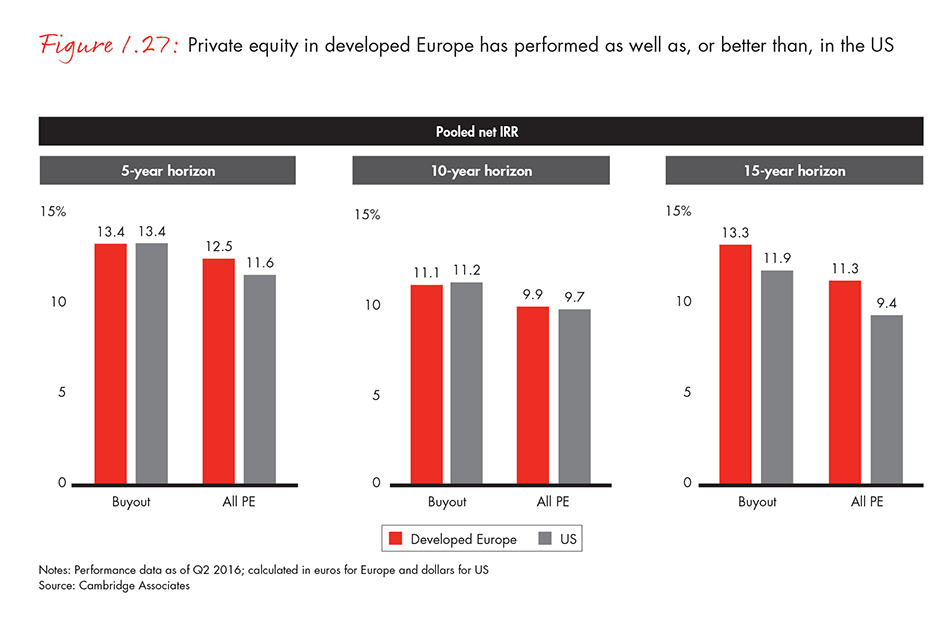

Part of the explanation lies in the ample supply of companies available to buy. The UK, Germany, France and Italy have relatively more large-scale companies per unit of GDP than many other parts of the world. Moreover, lower levels of deal value as a share of GDP in Western European countries, compared with the US, suggest that the industry still has room to grow. Most of these countries rank relatively highly on indexes measuring attractive conditions for private equity, in part because they have robust regulatory, legal and tax frameworks in place. Finally, the diversity of language and culture, challenging as they may be for cross-border businesses, do provide natural barriers to entry by outside firms that do not have a local presence.
Some LPs might object that the big opportunities have already been captured. Private equity in Europe historically has featured a greater share of sponsor-to-sponsor transactions, and skeptics could argue that investors have already wrung out the value-creation opportunity from these businesses so that a second or third owner won’t be able to generate strong returns.
We believe that the region still offers huge potential. Sponsor-to-sponsor deals have indeed been more prevalent in Europe, generating higher returns with less volatility than other types of deals. A Cambridge Associates study of European and North American buyout and growth investments made from 2004 to 2012 found the mean gross multiple on invested capital for the sponsor-to-sponsor transactions was greater than for other deals—2.6 vs. 2.3. More such deals should not be dismissed as “pass the parcel” but rather as a chance for a second owner to apply different capabilities to a company that has already operated under a professional PE owner and therefore could be a lower risk to acquire.
Some investors also worry about rising levels of dry powder, which could mean that too much capital is chasing too few deals in Europe. But buyout dry powder stands at historically high levels in North America as well, and relative to deal activity, dry powder remains at a more tenable level in Europe: The average duration to use buyout dry powder in Europe is 3.3 years—shorter than North America’s 4.3 years. While some of the dry powder could migrate from North America to Europe, or vice versa, Europe has the more favorable starting point.
Private equity’s strong performance in Europe does not, of course, guarantee smooth sailing over the next 5 to 10 years. And it’s not hard to see simmering problems that could erupt into real crises. Structural challenges such as an aging population mean that Western European countries could face labor shortages and soaring costs for social programs. The surge of migrants and recent terrorist attacks have exposed the inability of pan-European institutions to protect citizens in an increasingly unstable geopolitical environment. The steady erosion of Italy’s banking system is beginning to bite as bad loans approach 25% of GDP by some estimates. Finally, the uncertainty regarding Brexit’s exact path has become the lightning rod for growing skepticism about the durability of the EU. Given all these uncertainties, PE funds will need to carefully consider the realistic scenarios for Europe’s evolution and the effects of each scenario on any investment.
The right company can handle any macro scenario
Whatever path the macroeconomy takes, though, there are solid reasons to expect that the European PE market will continue to contain attractive investment opportunities. European markets have long offered an advantage to PE firms that have local knowledge and relationships cultivated through a local presence. The importance of personal networking on the ground limits competition for access to attractive assets.
Even in a eurozone restructuring scenario and consequent EU turmoil, pockets of local and subregional businesses will likely remain or become attractive. To succeed in Europe regardless of which macro scenario prevails, PE investors must carefully place their bets by geography and sector. Among the attractive subsectors will be those that have proven resilient through and after recessions—medical technology, cards and payment, software and healthcare providers among them. Some of these subsectors will continue to outperform if investors have the skills to find and vet them.
Yet choosing the right country or subsector for investment does not guarantee strong returns; choosing the right company matters much more. In all industries, even those characterized by fast growth and resilience, individual company performance varies widely—more so than industry performance. Bain analyzed S&P Capital IQ data to determine the annualized total shareholder return (TSR) of leading companies in nine industries from 1998 through 2013. The industry average TSR ranged from only about 1% in airlines to about 9% in fast-moving consumer goods, a difference of 8 percentage points. But among companies within these industries, the differences in TSR ranged from a minimum of 11 points to a maximum 35 points (see Figure 1.28).
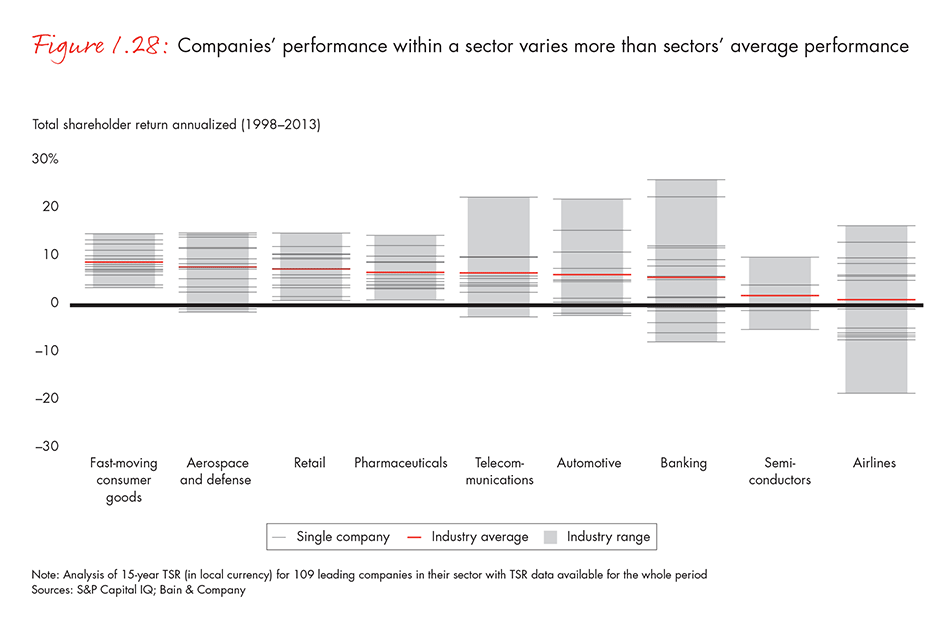

Opportunities in any industry may shift quickly. Periods of turbulence are especially fluid, with more firms changing their market cap quartile ranking than during expansionary times. In consumer products, for instance, 23% of European companies changed quartiles during 2007–2009 vs. 18% during 2013–2015, according to Bain analysis of S&P Capital IQ data.
These various metrics underscore why investors should invest heavily in due diligence of any deal opportunity so that they can bet on the right companies at the right price. Ultimately, deal pricing reflects investor views on growth and risk, and we do not believe that investors in aggregate are being hopelessly optimistic about Europe.
Weatherproofing for stormy times in foreign exchange
Foreign exchange risks present a separate challenge. Investors can navigate these choppy waters by ensuring that they integrate all foreign exchange scenarios into their due diligence and risk assessment of a potential deal. This entails looking at a target company’s mix of balance sheet and cash flow exposures in and around the eurozone, and Western Europe more broadly. For instance, what are the target’s supply chain arrangements, especially vendor country locations? To what degree does the target have the flexibility to hedge or shift those arrangements to respond to different scenarios?
Investors then can prioritize investment opportunities according to forecasts for currency movements. At the simplest level, if you expect the euro to strengthen, buy assets in euros or buy import-oriented assets that earn in euros. If you expect the euro to weaken, buy assets in foreign currency or buy export-oriented assets that are paid in noneuro currency.
As part of every investment decision, this calculation should consider the fund’s overall exposure to the euro and other currencies—with an eye on the possibility of a eurozone breakup. In that instance, based on the current macroeconomic situation, core Europe’s newly created currencies would likely hold their value better, while former eurozone periphery countries’ newly created currencies likely would devalue.
Ideally, investors would identify assets that have a “heads I win, tails I win” macro profile. An Italian exporter with a mainly domestic cost base that is doing well today would look even better with a substantially devalued Italian currency in a post-exit scenario. A German manufacturer with a significant Eastern European supply chain but a resilient domestic base would look better after a breakup, based on durable revenue streams and a significant reduction in costs. The more flexibility and options a business has to succeed under different macro scenarios, and the more macro scenarios with at least one favorable option, the better.
Questions for European due diligence
Posing a set of clear-eyed due diligence questions will help investors navigate the hazards of any macro scenario in Europe:
- What is the target’s industry resiliency and ability to sustain growth in declining macro environments?
- What is the effect on the target’s overall value proposition?
- Will the underlying trends supporting growth in unit sales continue to prevail?
- What is the effect on pricing?
- In a period of extreme turbulence, how will the company perform?
- How would currency fluctuations or a restructuring of the eurozone affect the company?
- How would a partial or complete EU breakup affect the company?
- How could potential changes in tariffs—between, say, the UK and EU or the EU and US—affect the business?
- How does this investment affect the fund’s overall exposure to Europe?
- In which national reference currency would returns be measured and paid out?
- If the macroeconomy continues to recover, how would that alter the target’s growth trajectory?
- Is there an opportunity to play the economic cycle?
- Will the underlying trends supporting unit volume growth prevail or even accelerate?
- Can pricing be used to create more value?
- Will the target’s competitive position get further entrenched? How would that affect deal economics?
No one knows whether the grand EU and eurozone experiments will endure another generation. But however they turn out, the region merits continued consideration. GPs who choose their investments carefully and manage currency exposure can thrive despite, or even because of, potential fractures and turmoil ahead.
Section 2. Let’s find a deal
With most deals now shopped by intermediaries and sold through auction, sourcing attractive proprietary deals has become harder than ever. As in the latter stages of a gold rush, PE investors have to get smarter about where and how to dig.
In the early decades of the industry, few PE firms contested head-to-head for deals. Pitch books were democratically distributed onto every firm’s desks, with relatively little chance of overlapping interest from several firms. Truly proprietary deals dominated most portfolios.
The industry has matured and attracted more investors worldwide, and most assets now draw multiple bidders at auction after being shopped around by investment bankers who make sure that all the right bidders are in the room. PE firms can no longer plan on finding many proprietary deals. When Preqin surveyed buyout fund managers in late 2016, some 36% of respondents said that it’s more difficult to find attractive investment opportunities compared with a year earlier, and just 2% said it’s easier (see Figure 2.1).
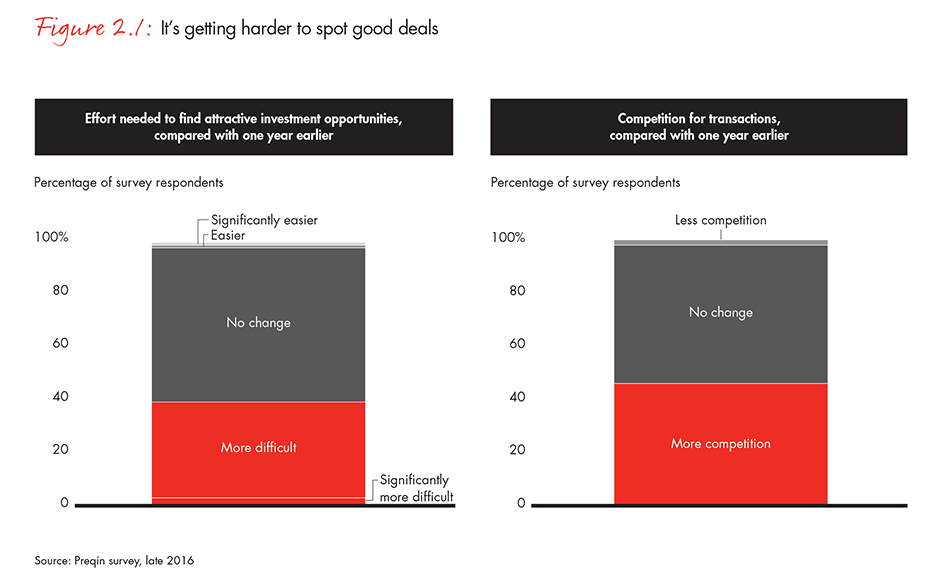

Yet PE firms can improve the odds of sourcing more of the right deals. In its 2016 analysis of 110 PE firms, Sutton Place Strategies reported that a typical firm will see only 18% of intermediated deals that might be relevant to them in their pipeline. Even firms in the top quartile for sourcing see only 26% of relevant deals (see Figure 2.2).
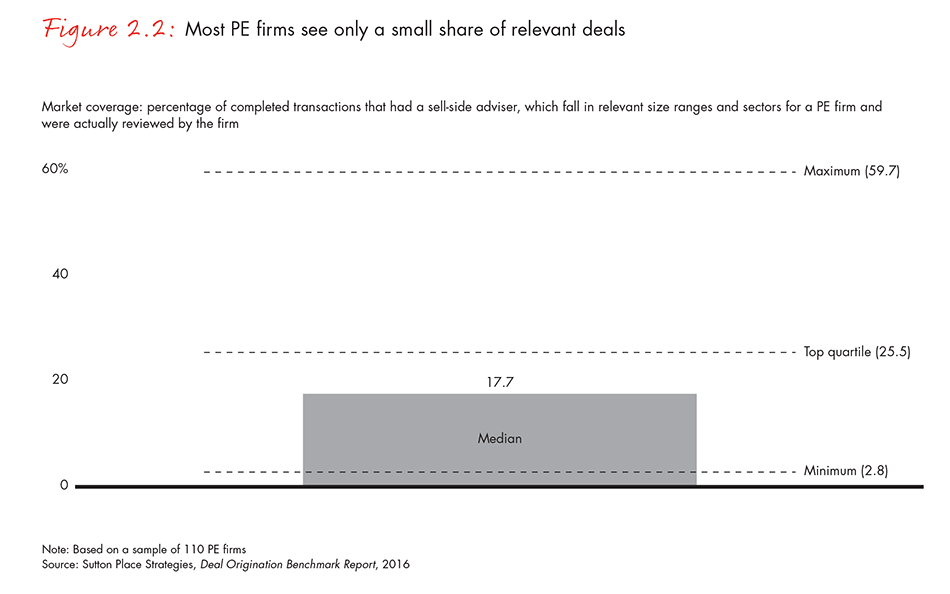

Rather than waiting for the offering book to arrive and then reacting at the same time as the rest of the crowd, today’s marketplace requires PE firms to put their best foot forward, actively looking to enhance the quantity and quality of deals entering their funnel.
A sharper vision and a broader team make for a smarter hunt
How can PE firms source more high-potential deals? Based on our experience working with firms on the hunt, it takes a systematic approach consisting of two angles of attack. Smarter sourcing first hinges on developing a sharp point of view about the type of deals the firm excels in and wants to find, even before any deal becomes a possibility. In concert, firms should expand their network of formal advisers and informal influencers as a way to find targets worth considering.
Clearly articulating the types of businesses that a PE firm wants to buy has several benefits. This stance identifies pockets of opportunity in which a firm might realistically generate alpha even in hypercompetitive markets. It affords an information advantage so that a firm can more rapidly spot deals it likes and aggressively pursue underpriced value. It also informs where the firm should concentrate in building out a network.
Which brings us to the second angle of attack: expanding the network of the right people in the right places. A strong network helps to identify investment themes, potential assets and high-quality management teams. It not only provides access to a broader set of deals but also informs deal theses and imparts insight in due diligence, including opportunities to create value.
When the deal engine is humming, there is a valuable interplay between these two streams of work. A strong network refines what types of assets the firm should be contemplating. If there is an asset that might sit in the firm’s sweet spot but that does not initially look attractive, a knowledgeable adviser might have insight—about product-line expansion, pricing, cost reduction or another area—that makes the asset more attractive. In turn, having a clear point of view allows the firm to communicate to its expanded network about which assets it is interested in obtaining.
Narrowing the aperture to focus on a sweet spot
Many longtime leading PE firms know that the true sources of their repeatable successes are encoded in their DNA—the combination of unique qualities deeply ingrained over time in their experience, ambition, talent and expertise. Finding, and sticking to, a firm’s investment sweet spot is critical because it provides a roadmap, showing deal teams the types of investments they should pursue and giving limited partners (LPs) compelling reasons to back them. We define a sweet spot as the realm within which a PE firm has a demonstrated record of creating sustained value for LPs—that is, where it has sourced and executed its more successful deals. The sweet spot defines the types of deals a firm seeks to make across at least eight vectors—namely, the firm’s strategy, geographic footprint, target ownership, the type of control it seeks to exert, the primary investment thesis, how it assesses risks in due diligence, how the investment committee process functions and the partners with whom the firm is willing to work.
A sweet-spot lens also highlights the critical issues to be tested during due diligence. And during bidding, the firm can bring its expertise to bear by making the case with the target company’s management that, as an owner, it would be the best steward. The firm’s investment committee will be more effective when it recognizes patterns that foretell success across deals. Bain’s analysis has found that deals within a firm’s sweet spot consistently and significantly outperform opportunistic deals that stray from it.
Understanding and adhering to one’s sweet spot is the bedrock on which any sourcing approach should rest. Scanning the sourcing landscape, we see four basic approaches PE firms are using to develop a sharp point of view on attractive potential deals. Whether a firm employs one or all of these approaches is less important than selecting the approaches that substantially increase the number of deal types in which the firm has strong odds of investment success.
Contrarian investing. Spotting or tolerating a type of deal that few others would entertain involves a willingness to zig when the rest of the pack zags—namely, investing in out-of-favor businesses or industries that are either due for a favorable turn of the cycle or can be fixed because they have valuable capabilities locked inside an outwardly ugly shell. The strategy requires a deep understanding of what drives demand in the target asset’s industry and when the recovery will occur. Investing in broken businesses also requires a high degree of self-awareness regarding the PE firm’s ability to fix what’s broken, perform rigorous due diligence and capture value after the close.
TPG adopted a contrarian strategy for many years. For example, it scooped up computer chipmaker MEMC in 2001, right after the technology bubble burst and at the bottom of the semiconductor cycle. MEMC was hemorrhaging cash and rapidly declining. But TPG spotted an opportunity to dramatically reduce the cost structure, and it expected the semiconductor business to recover. Through due diligence, TPG was able to drive down the purchase price to a symbolic $6 by identifying aspects of MEMC’s underperformance and including debt financing options. Four to six years later, TPG sold its interest in MEMC for a huge sum. (In fact, TPG’s founders started their firm with the proceeds from an early contrarian deal, Continental Airlines, which they bought in 1993 for $66 million, resurrected and exited in 1998 for $780 million.)
Apollo made one of the biggest gains in private equity through a contrarian bet on LyondellBasell, a Dutch chemicals and plastics company. At the time of Apollo’s investment, LyondellBasell was hobbled by billions of dollars of debt, a sharp increase in oil prices and falling demand for its polymers and chemicals in the wake of the global financial crisis. Apollo invested more than $1.4 billion in bonds to become LyondellBasell’s largest creditor, and after LyondellBasell filed for bankruptcy in 2009, Apollo emerged with a 25% equity stake. “We seek to buy when the world appears to be very, very cheap,” Apollo cofounder Joshua Harris told Bloomberg Markets. The company went public in 2010, and Apollo made its final exit in 2013. The $2 billion in total investment that Apollo sank into the company turned into a $9.6 billion profit.
Altamont Capital Partners has also thrived as a contrarian investor focused on value creation. In one case, Altamont acquired window manufacturer Cascade in 2012, just before the US housing market recovered. Despite weak profitability at the time, Cascade enjoyed strong loyalty among its dealers and distributors in the western states based on its product quality, pricing and customer service. Altamont quickly identified operational improvements that would boost profitability, and demand in Cascade’s region soon rebounded as new housing starts and repair and remodeling spending returned along with migration and population growth. Altamont subsequently acquired another regional leader in an adjacent market, implemented a similar margin playbook and thereby created a larger, more profitable enterprise—ultimately creating greater value at exit.
Playbook value investing. Some PE firms have a well-defined playbook that they use for specific types of assets, often in one or two vertical industries. All of these firms have applied their playbook in search after search, zeroing in on likely targets for which running the plays could unlock huge value and avoiding the distraction of assets outside their sweet spots.
Audax focuses exclusively on finding solid middle-market companies that it can transform, through add-on acquisitions, into market leaders. Since its inception, Audax has invested $4 billion in 101 platform investments and 534 add-on acquisitions, often in fragmented markets. In one example of its buy-and-build playbook, Audax bought Advanced Dermatology & Cosmetic Surgery, a US physician practice with a strong presence in Florida and Ohio. Some 40 add-ons and five de novo clinics later, Audax had built the business into a national platform and invested in centralized support services, resulting in expanded relationships with payers and higher clinic utilization rates. Since its initial investment in 2011, revenue quadrupled to more than $200 million, and Audax sold the asset to PE firm Harvest Partners in 2016, retaining a minority stake.
Macro trend investing. Some PE firms can construct a sweet spot by becoming expert in a broad global topic such as demographics, China’s economy or new forms of business models, and projecting the effects on consumption and other behavioral trends. They can then develop investment ideas by anticipating second- or third-order effects that the market has not yet fully priced. Focusing on select macro forces that will shape the investment landscape allows thematically oriented PE firms to quickly size up possible deal opportunities and gain greater confidence in choosing when to bid aggressively and when to hold back.
In the US, for example, the demographics of the millennial generation create interesting investment angles. The peak of this demographic cohort is reaching their late 20s and early 30s, prime years for family formation. Consequently, one can project the timing of the growth of retail spending associated with this family growth—a potential $4.1 trillion of additional child-related spending between 2015 and 2030, according to Bain estimates based on data from the US Census Bureau and US Department of Agriculture. Products ranging from food to shoes and apparel to private schools and educational supplies should get a tailwind.
A different sort of macro trend involves the ascent of the platform as a business model. Platforms facilitate the creation of value by third parties rather than through products developed internally, as illustrated by stock exchanges, auction websites such as eBay and funding sites such as Kickstarter. The rise of digital channels has greatly expanded the opportunities to create commercial communities, and clever investors can spot businesses that carve out a privileged platform position in their market.
Long-term macro theses also can help to pinpoint shorter-term aberrations in pricing before the general market notices. Assets might be overvalued or undervalued based on flawed assumptions about consumer behavior—for example, assuming that most millennials or younger generation Xers will remain urban dwellers when, in fact, 30- to 44-year-olds are moving to the US suburbs at a faster rate than in the 1990s.
In the case of China’s growth, investors who gained an acute understanding of global linkages could spot opportunities early. Those who recognized cross-border supply chains and trade patterns could identify the industries that benefited from China’s investment-led growth strategy—from iron ore to copper to industrial machinery—in places as far-flung as Brazil and Germany. They could also foresee that these same industries would lose momentum as China tried to pivot from industrial-led growth to a more consumption-based economy.
Understanding changing trade patterns can also yield early warnings for shifts in exchange rates. For example, the US dollar/Australian dollar exchange rate is highly linked to the relative levels of investment in each economy, while the Canadian dollar/US dollar exchange rate is heavily influenced by bilateral trade.
Cross-pollination investing. The organizations inside PE firms often compartmentalize along lines of industry, sector or geography, with little collaboration or communication across the lines. Yet some firms have bet on success begetting success, taking investment theses that work well in one geography or market and playing them out in other areas.
Actis, for example, has made multiple investments in education across different regions. In 2008, it acquired Ambow Education in China, then listed Ambow on the New York Stock Exchange in 2010. Another Chinese deal emerged in 2011 when Actis bought EIC, the largest firm in the Chinese overseas education counseling market. Based on these initial investments, Actis took its expertise to Brazil. There, in 2012, it spent $102 million to take a significant minority share in Universidade Cruzeiro do Sul, which provides higher education, and paid $68 million for CNA, one of the largest private suppliers of English language training in Brazil.
Welsh, Carson, Anderson & Stowe has pursued a similar path through investments in several payments companies, translating success in the US into similar ventures in Europe. Welsh, Carson acquired Ruesch International in 2004 and TransFirst in 2007, more than quadrupling returns on the latter. Then the firm went on to purchase European payment service provider GlobalCollect in 2010.
Bain Capital managed to cross-pollinate that quintessential American fast food, pizza, to a nation with ancient dining traditions. In 1998, Bain Capital took a majority stake for $1.1 billion in US-based Domino’s Pizza, the world leader in pizza delivery. Domino’s went public in 2004, and Bain Capital made a full exit in 2010, earning a five-time return on investment over the 12 years. But the firm saw further potential in pizza, and that same year invested $50 million for full ownership of Higa Industries, the master Domino’s franchisee in Japan and first pizza delivery chain in that country. Three years later, Bain Capital sold a 75% stake for $123 million.
For this strategy to flourish, compartments must be breached. Deal teams covering different sectors or geographies need to talk often with other teams about investment theses, aiming for an early view on what they could likely replicate from deals already planted in the ground. Local market dynamics may or may not translate well in another market.
The four approaches described here don’t have hard-and-fast boundaries, and each is compatible with the sector organization common to many PE firms. In fact, deep knowledge of a sector can enhance the speed and quality of deal sourcing and due diligence in that sector. And any of the approaches can be applied to develop a heat map of geographies and subsectors that contain rich pockets of target assets for the firm to pursue. Each approach, though, will be more effective when it’s congruent with a PE firm’s investment sweet spot.
Network effects expand the deal universe
Developing a rich, detailed point of view about which deals to pursue is just half the battle. To uncover more hidden gems, PE firms will have to spend time building out their network. Once a firm has defined its sweet spot and has a strategy for sourcing suitable potential deals, it can use a strong network to help execute the strategy. The goal of an expanded network is to gain an edge even before a deal comes to market, by becoming top of mind with intermediaries, building a relationship with the target company’s management team or starting due diligence early. If a firm excels in carve-outs, for example, it can knock on the doors of relevant companies that it knows have stray business units they might sell at some point in the future.
Two types of networks are worth cultivating: an institutional network of people who are always available when needed and a temporary network deployed for a specific opportunity or short-term series of deals. Each network should consist of individuals who can give the PE firm truly differentiated insight or access through the deal cycle. It should be large enough to provide the needed insight but small enough to be manageable. Advisers, industry experts, lawyers, bankers, potential partners or targets, potential buyers, intermediaries, ex-CEOs, academics, leaders of trade organizations, and existing or past portfolio management teams all could play a useful role. They populate an efficient ecosystem that helps general partners (GPs) identify, triage and pursue the most attractive opportunities.
Formal advisers, in particular, can address several needs. They improve the quality of deal flow as they filter opportunities, facilitate introductions to management teams or contribute to the underlying analysis of an investment theme. For every 100 potential targets that go into the funnel, we estimate that only 1 or 2 will result in a closed deal (see Figure 2.3). Advisers should help ensure that the top of the funnel is not too wide so that the firm doesn’t waste resources on lower-quality opportunities, or too narrow, which could cause the firm to miss potentially good opportunities. At subsequent stages of the funnel—from which deals go to the investment committee for initial review to final committee decisions to actual bids—advisers help shepherd good deals and kill bad ones. The cost of an expanded network usually is offset several times over by a more efficient allocation of resources evaluating the pipeline. For high-potential targets, advisers raise the odds of a deal closing by adding credibility to the offer and helping the deal team get up to speed faster.
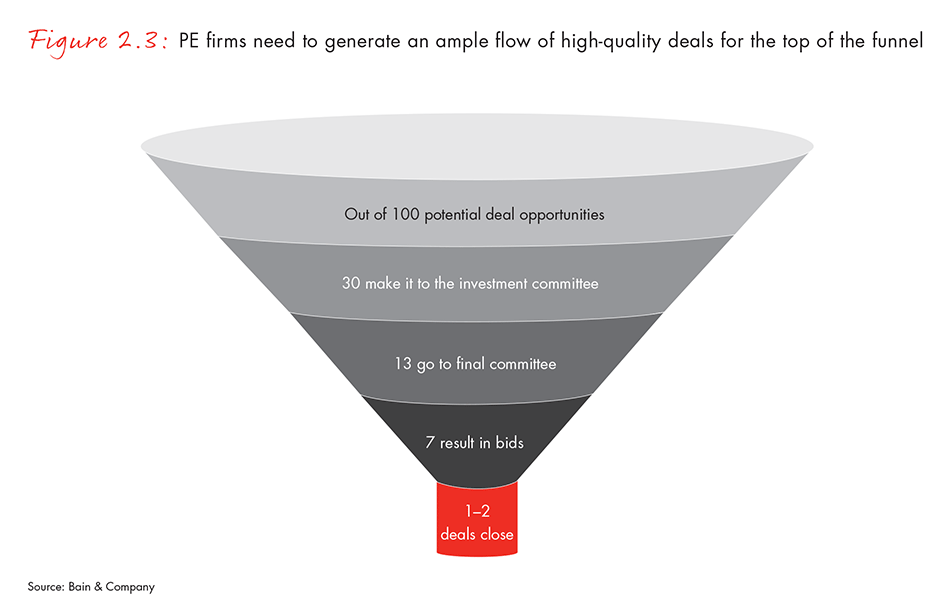

Some PE firms are deploying their advisers in very specific roles. EQT uses experts on call, retaining former senior executives to help pursue assets in industries they know well. Temasek Holdings has taken a slightly different tack, building a network of well-connected executives in Europe and the US—such as PepsiCo CEO Indra Nooyi—who are retained to help with business development. KKR uses regional experts, such as the former president and CEO of Bolloré Africa Logistics, to help expand KKR’s franchise in Africa. And Advent International has invested in about 70 part-time operating partners who are assigned to sector-specific investment teams to focus on sourcing deal opportunities in those sectors.
Filling out a robust network requires significant time and attention from partners. The highest-priority contacts will be well-connected individuals who are advocates for the PE firm and will make introductions to others. Communicating regularly with them makes substantive contact easier to establish. Tactics for regular contact include sending along relevant articles with a personal note, finding shared interests to connect on a more personal level and scheduling breakfast or lunch when traveling to their city. Based on our experience with firms that excel in networking, we suggest that managing directors spend about 30% of their time networking, senior directors 25% of their time, junior directors 10% to 15% and formal advisers 50% (see Figure 2.4). That alone entails a change in behavior for people who spend much of their time poring over spreadsheets. They also should be accountable for their performance, measured against set goals such as establishing relationships at potential targets, attending high-value industry conferences or recruiting advisers.
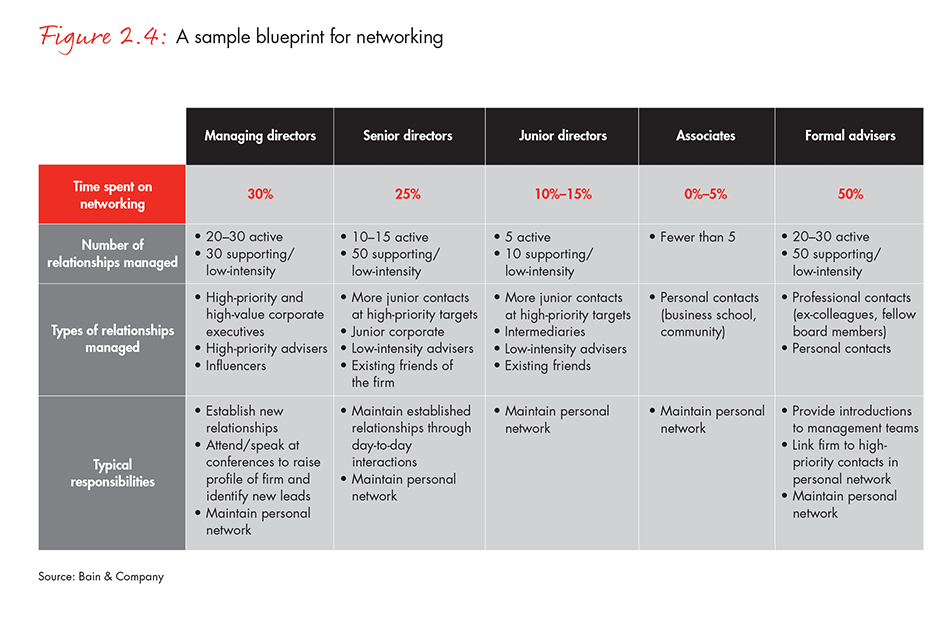

Quality trumps quantity in networking. A thoughtful, even analytical, approach to building relationships is the best way to find the right people. Since the average firm will see only 18% of deals that might be relevant to them, one way to identify gaps in the network is to examine which deals in the sweet spot were bought by other PE firms or corporate buyers and then run through a series of telling questions:
- Which of these deal processes were you aware of? Which made it into your pipeline, and which did not?
- If you were not part of the process, why not? Did you know the people involved, and if they did not think to call you, was it because you did not crisply articulate your sweet spot or communicate it broadly enough?
- Do you lack a relationship with the intermediary? If so, should you invest time to become acquainted because he or she will likely shop for more deals in your sweet spot?
- If a deal made it into the pipeline and you rejected it, did the winning bidder spot something you missed? If so, which experts could augment your deal teams to better size up opportunities in the future?
There’s always an excuse to put off networking, unless it’s reinforced by the culture and compensation system. But with proprietary deals so hard to come by, expanding the circle of advisers and influencers, combined with a sharp point of view about what types of deals will make the best fit for a firm, is the best route to opening up new sourcing opportunities.
Giving new prominence to operational due diligence
With strong returns and ample liquidity in recent years, the PE model appears to be working just fine, creating value and profitable exits for investors. And many GPs are feeling fairly buoyant about their performance of late.
Still, it’s useful to probe beneath the high-level metrics to understand what accounted for the strong results, as that exercise can inform what funds might do differently in the future. Retrospection may not be common in the PE industry, but it is an essential discipline for assessing how effectively a fund creates value. One good litmus test to indicate the health of a value-creation model compares deal model forecasts with the actual results. Did the portfolio companies meet revenue growth projections? Did they achieve forecast earnings before interest, taxes, depreciation and amortization (EBITDA) margins?
A look beneath the surface does, in fact, reveal a less rosy picture of recent performance. For the subset of deals in Bain’s proprietary database invested after the global financial crisis, we compared deal model forecasts for revenue and EBITDA margin expansion with the results that each portfolio company actually achieved over the holding period. Most portfolio companies, we found, had relatively accurate projections of revenue growth. However, most did not attain the projected higher profit margins (see Figure 2.5). This breakdown in execution had not come to light sooner because it was masked by macroeconomic factors, notably multiple expansion. Since the global financial crisis, acquisition multiples have risen significantly around the world. That’s not what PE funds anticipated. In their deal models, funds penciled in restrained expectations for multiples upon exit. For the sample of deals Bain analyzed, funds assumed an average multiple at exit of 8.8 times EBITDA, but the realized exit multiple turned out to be much higher, at 10.9 times EBITDA. GPs had the good fortune to make up the shortfall in margin expansion through unforeseen multiple expansion (see Figure 2.6).
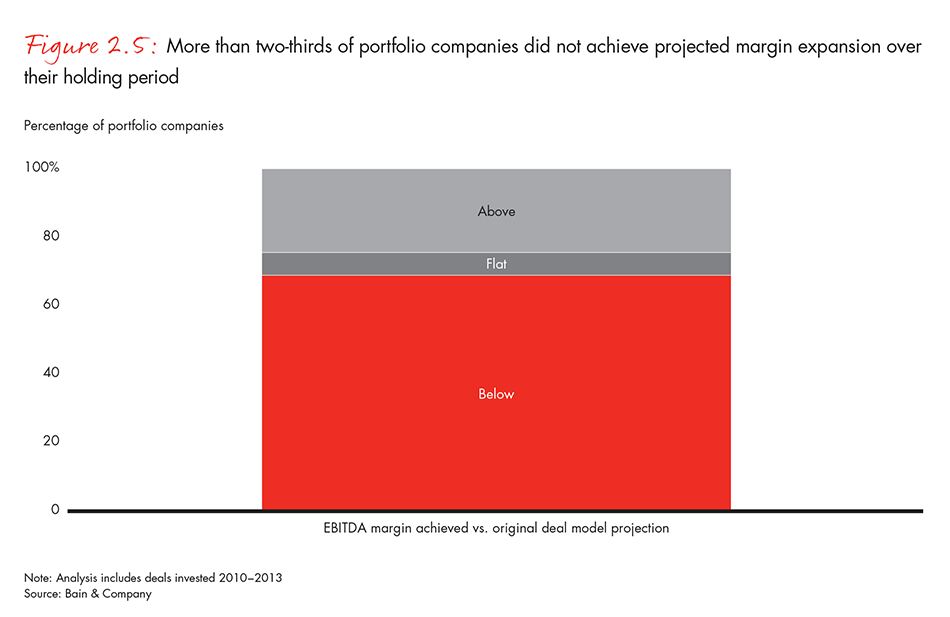

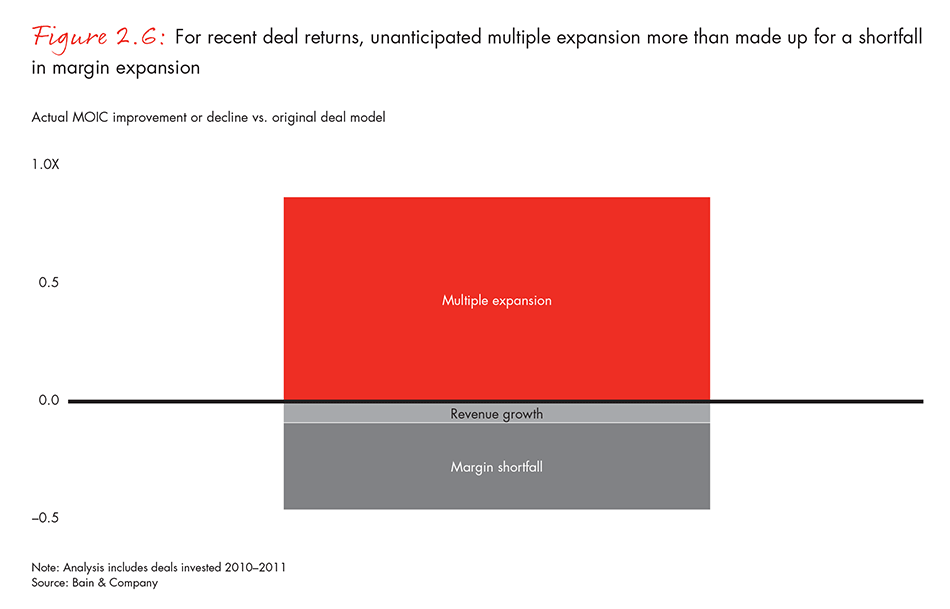

PE funds will not be so lucky with future deal returns, we believe, as few scenarios support a case for further multiple expansion. Much of the recent expansion was fueled by record-low interest rates, which greased the wheels of debt and, therefore, supported higher deal prices. Unless interest rates decline further, multiples likely will top out.
Future returns for PE funds will have to rely more on operating-margin expansion, which requires highly engaged, active ownership. Forward-looking GPs will want to deepen their operational due diligence so that they can exceed industry benchmarks and improve margins despite a tougher macro environment. Success in this regard will come not through simple across-the-board cost reductions but rather by identifying how to restructure operations in ways that will yield both cost reductions and top-line growth.
Leaks in the profit bucket
The time is ripe for a dose of introspection to address the question: What accounts for the mismatch between funds’ expectations and portfolio companies’ subsequent underperformance on operating metrics? PE firms often assume that once the deal is done, profit margins will increase—just because they should increase. But it rarely turns out that way. Examining those deals that failed to achieve expected margins reveals issues that hinder performance. There are four important topics that many GPs do not cover sufficiently in their deal models: price erosion, cost inflation, capital expenditures or reinvestment in the business, and a possible shift in product mix and volume over the holding period. Each of these issues can cause the bucket of profits to spring leaks.
Start with price erosion. It’s dangerous to assume in a deal model that prices for a company’s products will do anything but go down. Except in monopoly or oligopoly markets, prices fall in every industry. Typically, the industry starts with a product development phase, characterized by scant competition and the ability to command high prices. Wide margins early on make any business a prime target for greater competition. With increased competition comes increased supply, and as companies accumulate experience, prices inevitably decline.
Price curves are well established in industries ranging from televisions to nonfashion clothing, so many companies can predict price erosion with a high degree of accuracy. For example, pharmaceutical firms understand that prices decline sharply within just a couple of years after a drug patent expires (see Figure 2.7). Any due diligence, therefore, should map out the relevant price experience curve for the target industry, plot the industry’s products on the curve and realistically project how prices will change over the holding period.
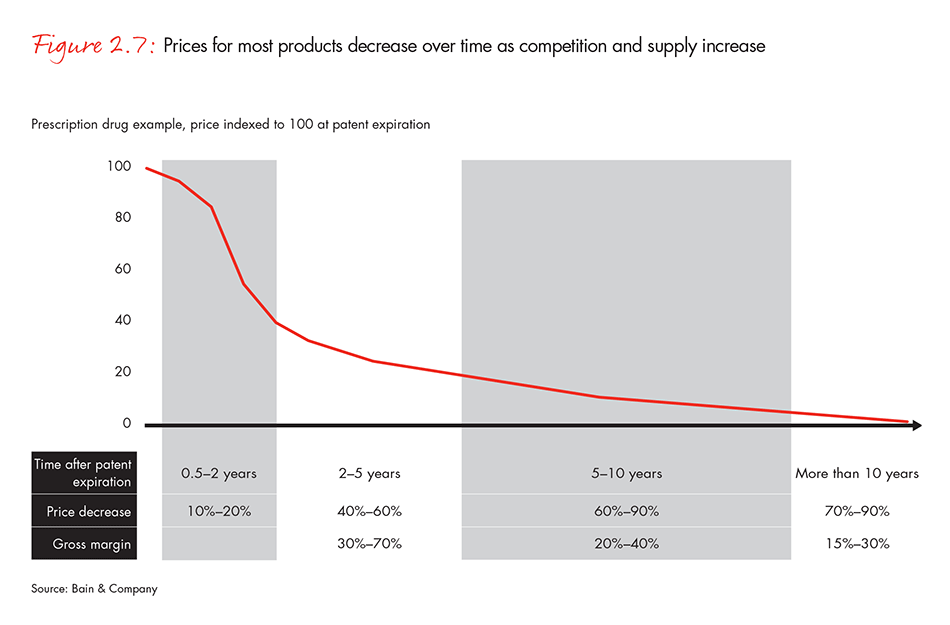

Turning to costs, overly optimistic assumptions can be equally dangerous. Many funds assume that they will manage down all costs over the holding period. Yet like it or not, some costs will rise. For example, in a labor-intensive business such as a brick-and-mortar retail chain, it’s not realistic to peg labor as a percentage of revenue and hold it constant.
Managers will need to aggressively reduce costs in those categories that lend themselves to cutting to compensate for the categories that will stubbornly remain flat or rise. Attaining a low-cost position enables a company to expand its margins even if it has to give away some of the cost reduction to consumers in the form of lower prices.
The third key issue that emerged in our analysis involves misjudging the required investment in a business over the holding period. For example, companies may need to invest in marketing and sales resources in order to increase revenues. Or they may have to make capital expenditures in order to achieve or maintain a low-cost position. And any cost savings achieved could easily be diverted to the demands of the business before the savings have a chance to flow into margin expansion.
Finally, there’s a good chance that a company’s product mix and volume could change substantially over the holding period, which in turn could alter its margin profile. Companies in fast-moving consumer goods or fashion retailing, for example, have to contend with sudden shifts in consumer taste that can reshuffle their product mix in a matter of months or weeks. Managers can’t precisely predict every shift, but they can anticipate the risk through a version of scenario planning that lays out a best and worst case for each product line.
Successful investors explicitly address the four challenges of price erosion, cost inflation, necessary investment and shifting product mix when they construct revenue and EBITDA projections. While an individual portfolio company might not have to contend with all four, the odds are high that at least one will apply. Certain packaging businesses, for instance, have up to 100 basis points in price erosion and between 200 and 300 basis points of nonmaterial cost inflation per year, and their competitive need for capital expenditures can push down free cash flow to zero. Investors and management teams have to figure out how to refill the margin bucket faster than the leaks that will make it run dry.
Having observed the PE industry over decades, Bain has identified a set of winning factors highly correlated with deal success. Bain has also documented warning beacons likely to undermine a deal’s success. Margin assessment is the only factor that makes both lists. Funds that accurately assess margin improvement opportunities during due diligence and capture those opportunities after acquisition will be rewarded. On the flip side, unrealistic expectations for margin improvement in the deal thesis can spell disaster.
A route to full potential
The practical route to accurately assessing and realizing the margin expansion opportunity starts with operational due diligence, combined with commercial due diligence. Together they provide a robust, realistic view of the target’s full potential. Whereas commercial due diligence provides a perspective on how fast the target company’s market will grow and whether the target could increase revenue faster or slower than the market, operational due diligence assesses the opportunity for the target to expand margins.
To be clear, effective operational due diligence does not involve a simplistic benchmark comparison or a high-level assessment of operational improvement areas done at the back end of a commercial due diligence. Instead, the approach probes deeper into operating assumptions through several key steps.
Understand the baseline. A fund should assess the cash and margin improvement opportunities that current company management lists in its plan. This review enables the fund to understand ongoing and planned initiatives. One should also cast a skeptical eye by comparing the shape of the target’s cost base, cash on hand and profit-and-loss statement with direct competitors and industry standards.
Ferret out the potential. Most target companies have not reached full potential to improve operations or to enhance the top line. And there is nearly always opportunity if one knows where to look. Using benchmarks and expert perspectives, PE firms can assess, quantify and prioritize the opportunities. They can make a disciplined march through the target’s cost structure—beginning with procurement; moving through to manufacturing or service delivery; then customer service; and ending in selling, general and administrative (SG&A) expenses. In parallel, they can look for ways to optimize net working capital, real estate, inventory, capital expenditures and other components of the balance sheet.
Depending on the nature of the business and the industry, other value-creation levers could be available. These range from better supply chain practices to improving salesforce effectiveness and optimizing pricing strategies. Experience helps investors know which levers to pull first in a particular industry or type of business so that they can home in quickly on the opportunities. Veteran investors have learned not only how to size up the opportunity but also whether it will be easy or hard to capture the value.
Analysis of procurement, for instance, would undoubtedly uncover pockets of waste, which a new owner could address using various levers. It could reduce pricing with current vendors, consolidate vendors or stock-keeping units (SKUs), reduce consumption internally, or reduce working capital by forward buying and by better managing inventory and accounts payable.
This is how Apollo reaped enormous value from its 2011 acquisition of a majority stake in Constellium, a producer of aluminum products. Apollo spotted an opportunity to buy an undermanaged asset during a down cycle of the aluminum market, having identified potential savings of €50 million in operating expenses in diligence. To capture the savings, Apollo undertook a deep transformation project to improve Constellium’s cost base, with an emphasis on procurement. At the time of acquisition, Constellium’s purchasing operated in silos, with each business unit having its own purchasing team and with very limited bulk purchasing. Apollo identified the major cost reduction opportunities by purchasing category, set cost reduction targets and measured progress, and it redesigned the purchasing organization while developing a new performance-oriented culture. By 2013, the aluminum market had recovered, and Apollo floated public shares on the New York Stock Exchange. At that exit, Apollo realized a very high multiple of money and IRR on the deal.
In another case, consider a target company that relies heavily on a direct sales model. Due diligence would explore ways to increase salesforce effectiveness by answering a set of pointed questions:
- Does the firm clearly segment and prioritize its customers?
- Does the sales coverage model and incentive structure align with those priorities?
- How does the size of the salesforce and the productivity per sales representative stack up against competitors?
- How do the rates of sales staff tenure and turnover compare with those of competitors?
- Do onboarding and training processes get reps up to speed quickly and effectively?
- What marketing plans exist, and to what extent are they tailored to different customer segments?
Map out the road to full potential. The extensive work performed in the previous steps should establish a revised base case in which the PE fund has greater confidence, as well as an upside case. Achieving the benefits of the upside case will take a substantial effort along several streams of action. This stage thus involves drawing up a high-level transformational roadmap on how to capture the identified savings and revenue enhancements. The initial roadmap should include the resources required and a projected timeline for the work on each lever. The map must also identify potholes and hazards along the way—the key risks to implementation and the tactics available to mitigate each of the risks.
Lower risk, higher confidence
Although commercial due diligence and operational due diligence pursue different goals, they work best together, by developing an integrated view of the target’s full potential. If a PE fund underestimates full potential, it will lose the deal in a highly competitive bidding environment. If it overestimates, the fund may win the auction, but the deal will not deliver the anticipated returns.
During uncertain economic times, the best way to reduce the risk of a deal is to attack baseline costs from year one. Through operational due diligence, a PE firm gets a head start on pursuing savings immediately after the deal closes, having already identified and sized up the biggest opportunities. Freed-up cash flow from expanding margins can be used to aggressively pay down debt and invest in the business strategy.
CVC’s diligence and subsequent restructuring of Swiss telecommunications provider Sunrise illustrate how targeted operational improvements, for both efficiency and effectiveness, can redirect resources to the most valuable endeavors. Before CVC bought Sunrise in 2010, its diligence found that the business was positioned as a low-price competitor in the market but that it had lost control of fundamental operations. Specifically, Sunrise’s network quality had the worst performance in the market, and the poor quality of customer service, which was heavily outsourced, led to very low customer loyalty, especially compared with competitors. These problems, CVC surmised, accounted for Sunrise’s substantial customer churn, yet Sunrise senior management devoted scant attention to the quality of operations. And when key competitor Swisscom lowered its prices, Sunrise no longer had a strong price position, which made the need for change more urgent.
Setting Sunrise on a new course involved putting customers’ priorities at the center of decision making. To close the performance gap with key competitors, CVC made new investments in the network and launched a comprehensive Net Promoter System ® to mobilize employees around the goal of earning customer loyalty and advocacy, because loyal customers improve a company’s economics. These moves occurred in a deflationary environment, which meant that Sunrise needed major cost reductions. The savings flowed from leaning out overhead and management, lowering network costs through smart procurement with its network provider, enhancing service quality and investing in more digital processes, which resulted in fewer calls from customers and thus a sharp drop in customer operations costs. CVC’s turnaround expanded EBITDA margins from 26% to 31% and allowed Sunrise to fuel growth through higher-quality services and a value proposition that customers found simple and fair. As a result, Sunrise went public in 2015, delivering a highly attractive IRR to CVC.
Vestar went on a similar cost/growth hunt during its due diligence and subsequent restructuring of US-based processed food giant Birds Eye. Vestar bought Birds Eye for $175 million in 2002 after a diligence that found low return on invested capital in the processing and storage parts of the value chain as well as several low-margin categories such as private-label frozen vegetables. After the deal close, Birds Eye quickly discontinued or repriced low-margin products, dramatically simplified its SKUs and sold off processing and storage facilities, freeing up substantial capital to reinvest in other parts of the business.
Diligence had also revealed major growth opportunities, and after Vestar made many of its cost moves, it invested heavily in marketing and R&D to guide Birds Eye into more premium, value-added product lines, such as Steamfresh, which packages vegetables and meals in a specially designed bag for microwave ovens. That innovation helped propel Birds Eye’s steamed vegetable category, part of a larger transformation of Birds Eye from commodity vegetable producer to a leader in branded foods and meals. By 2009, Vestar sold Birds Eye to Pinnacle Foods, a Blackstone portfolio company, for $1.3 billion, generating a 4.4 times multiple on invested capital and an IRR of more than 30%.
The interplay between the two streams of due diligence is where cost and growth converge, as the double-barreled approach gives PE funds a better understanding of how much capital could be freed up to reinvest. Until it’s clear where capital will come from, growth opportunities often don’t become feasible or even part of the senior management agenda.
Data mining your way to faster, better due diligence
In the hypercompetitive auction processes now common to PE markets, investors look to gain an edge in drawing insights and bidding with greater confidence. One emerging vein of raw material to be mined is the wealth of unstructured data available on the web. When used effectively, various types of web data can increase the speed and reliability of insights and thereby provide a competitive edge.
From scraping social media sites to mining e-commerce traffic, some PE firms are starting to take advantage of new digital data sources and advanced analytical tools. By incorporating the data into the due diligence phase, PE firms have developed proprietary insights faster and more comprehensively, giving them greater confidence in the price they should pay for an asset. What was a long, laborious, mostly manual effort to learn about the strengths and flaws of a business now can happen in just days.
Software tools now can organize and analyze customer reviews, geographic information, employee compensation, employee and organizational data, social media sentiment and other web data (see Figure 2.8). By augmenting traditional research such as interviews and store visits, advanced analytics often provide answers that are more exact than traditional sampling or probability ranges.
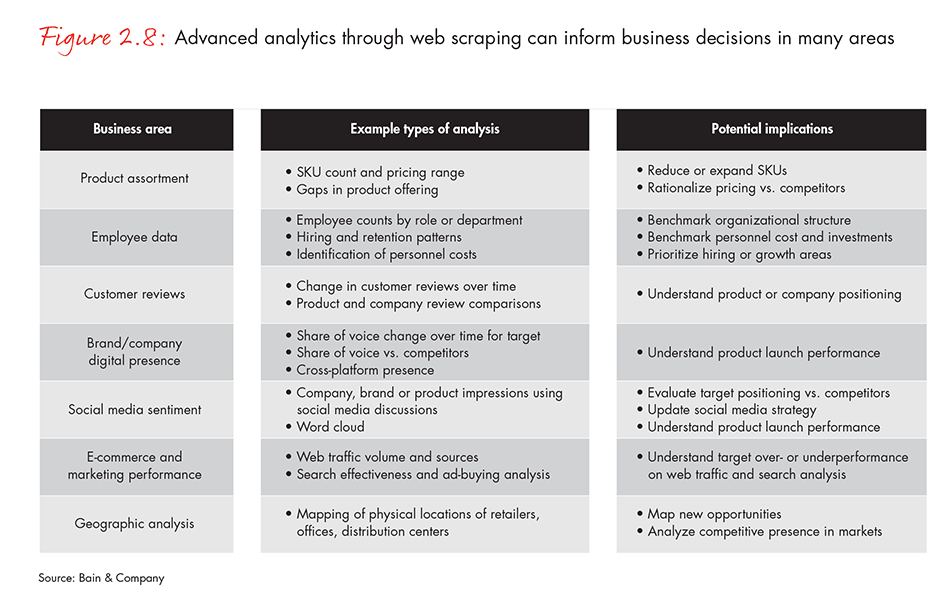

Once the data has been collected, traditional analytical tools such as Excel or SPSS Statistics may not be sufficient, so PE firms should explore additional tools such as Tableau. Software that both analyzes and visually displays data can quickly reveal important patterns that might take too long to produce using traditional spreadsheets and charts.
For instance, consumer interviews done during due diligence may have a limited reach. Those interviews can be complemented with analysis of thousands of online reviews and commentary. Similarly, manual pricing and product assortment checks used to be done at one time or over a limited time period. Now, software algorithms can scroll through archived web pages to track a long history of pricing and assortment data for a target company and its competitors. And mapping software can overlay demographic data at a local level, with store locations or other relevant geographic data, in order to identify underserved or overserved locations. Many of these software applications have interfaces that enable users to visualize different combinations of data quickly.
PE firms are applying advanced analytics during due diligence on several fronts.
Product assortment. Potential acquirers collect and analyze product assortment data to assess the relative pricing, assortment and discounting strategies of target companies in retail, consumer products and technology. In a due diligence of a women’s clothing retailer, a SKU assortment analysis revealed that the retailer provided a wide selection of items at comparatively lower prices (see Figure 2.9).
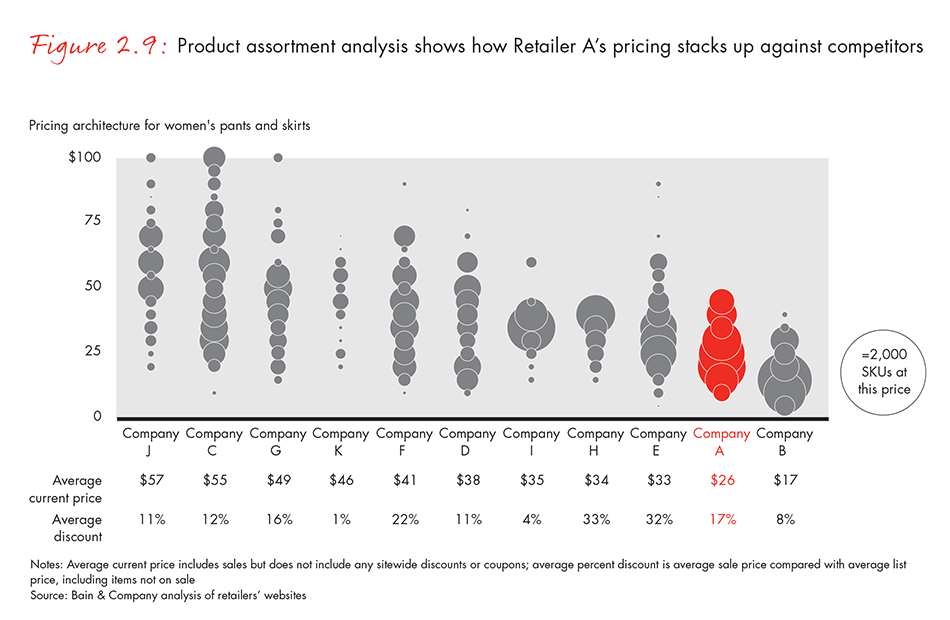

Employee costs and organization. Online data allows a diligence team to sort employee counts by role or department, estimate personnel costs and assemble a rough organization chart. This provides a perspective on the employee mix and cost, as well as on the caliber of talent management. A profusion of spans and layers, for instance, may signal an opportunity to reduce headcount and improve how the company manages talent. In a due diligence of a sporting goods retailer, Bain combined digital data with store visit observations for the potential buyer. We concluded that the target firm, compared with its peers, had a higher proportion of store managers and support staff relative to store employees, which enabled the buyer to accurately project savings from staff cuts.
Customer reviews. What customers write about vendors can deepen the understanding of differences among competitors in products, service or the overall experience—or among a target company’s locations. One due diligence of an amusement park company analyzed reviews on TripAdvisor to confirm primary research and understand the company’s competitive position.
Social media postings. Data compiled from social media postings yields trends in sentiment and share of voice for a brand that people comment about on the web. In the due diligence of a European retail health provider, an analysis of online blogs, forums and news helped a PE firm confirm how familiar people were with the provider (see Figure 2.10).
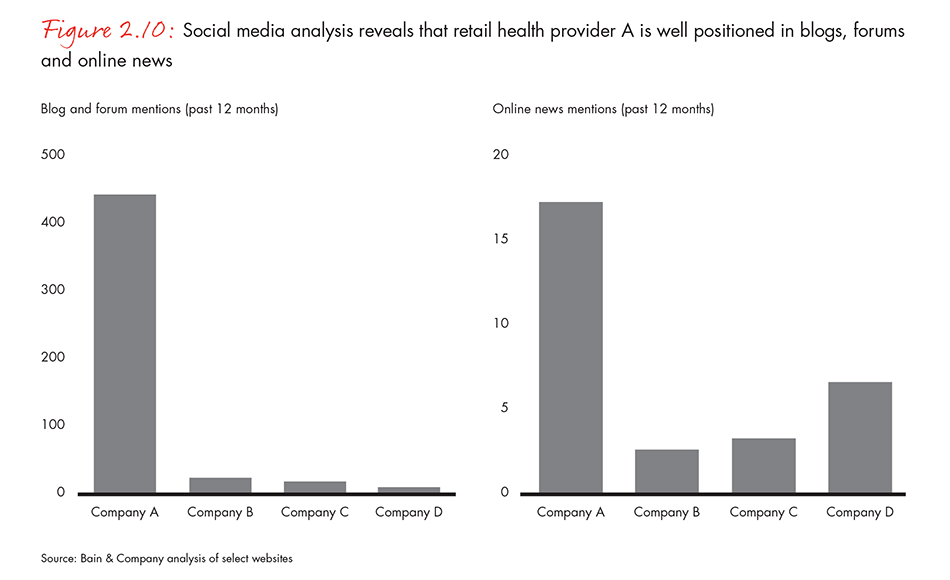

E-commerce. Software firms crunch web traffic data to assess the search effectiveness, conversion rates and purchase sizes of online retailers. The analysis helps to identify the size and nature of post-acquisition sales opportunities. One PE firm assessing a US retailer used e-commerce analysis to create a post-acquisition strategy that outlined the potential next steps the retailer should take to catch up with—and possibly pass—the competition.
Geographic presence. Geographic analysis can show the competitive presence in individual markets and potentially underserved markets. And the geographic data might be combined with other data for more nuanced analysis. For example, the due diligence of a US industrial products distributor used core location data from the target company and competitors to reveal which postal codes merited expansion or new facilities (see Figure 2.11).
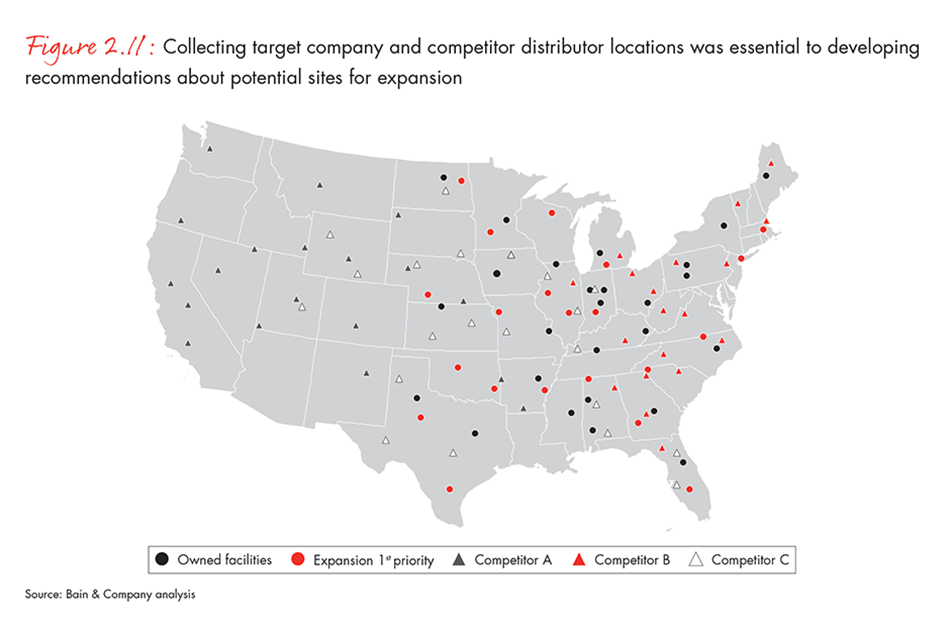

New forms of analytical software emerge every day. One recent type of software accesses proprietary credit card networks to analyze card transaction data. Another uses language processing to find semantic connections and patterns across companies, which can be displayed in graphic formats. All of these proven and emerging tools are finding applications in due diligence and later in portfolio value creation.
No substitute for judgment
Even the best analytical tools have limitations—chiefly, they have access only to materials available on the Internet. They don’t yet replace other methods of research such as market participant interviews, customer surveys and intercepts, store visits and literature searches. For comprehensive insights, the best-informed due diligence will use web scraping to complement traditional research.
Moreover, most of the tools require advanced technical capabilities. Making good use of them often involves working with experienced consultants and third-party vendors or building capabilities in-house. While the tools can save valuable time during due diligence, it’s critical to plan ahead to ensure they’re used correctly and within the right time frames.
Finally, software tools do not replace business judgment. For example, just a few positive or negative reviews could easily skew average review ratings of smaller locations or less popular products. Likewise, in analyzing product assortment, scraping data on sale days or unusual periods such as holiday seasons will skew the results. Algorithms have not yet mastered cultural quirks that only a human can interpret.
Rewriting the playbook to combine cost and growth
High asset prices and less confidence in market beta to lift returns in recent years have greatly narrowed the margin of error for generating alpha and delivering acceptable returns to LPs. GPs have responded by experimenting with various post-close approaches. Some have hired functional experts to pursue opportunities across the portfolio. Others have developed robust plans to more consistently create value. A few have assembled big teams of generalist, consulting-like resources in-house. But many of these approaches have not been centrally organized and have lacked guiding principles.
GPs are now looking back at the past decade of trials and errors to identify lessons and patterns that will shape their next approach to value creation. They are figuring out what they are good at, what has and has not created value and where and how their funds have made money for investors. They are looking for any threads connecting successful deals, as well as explanations for less successful outcomes. These reflections have started to move the industry into the next stage of value creation, past experimentation to a codification of battle-tested approaches.
Codification is not completely new. Some PE firms, particularly certain value investors, have long used a formula of sorts to create value. These formulas have evolved over time to become more complex playbooks, which consist of detailed, sequenced actions taken to maximize value from each investment.
Among GPs that have crafted playbooks, many try to get ahead of EBITDA projections in year one. Why the rush? Getting ahead of the year-one forecast provides at least three benefits: It provides more flexibility to invest in a full-potential program, it builds in a cushion against unexpected turbulence, and it can inject some balance sheet flexibility via debt pay-down or dividend recapitalization.
While many playbooks started with a focus on cost reduction, the most successful ones today contain a strategic blend of cost and growth moves. Cost cutting is no longer sufficient on its own to generate strong returns. To reliably create value and obtain the desired multiple upon exit, a portfolio company must be set up to achieve profitable growth over the long term.
The application of a playbook to a target company will depend on three factors. The first is the industry, as specific cost bases and capabilities have more or less relevance to individual industries. Manufacturing optimization clearly looms large in the chemical industry, and marketing and branding figure prominently in consumer products. The second factor is the investment thesis: A playbook suited to a target company that has solid operations and is poised for growth may not work with a bloated company in distress. Finally, the playbook should accommodate the target’s strategy to move the business forward. Companies competing in the same market can have very different strategies, and strategy determines where a PE firm can cut and where it should double down on investment.
Given these factors, PE firms with the most highly developed playbooks today tend to define their deal sweet spots narrowly. They may focus on investments in a single industry or on businesses across industries but with similar investment theses and opportunities for creating value.
3G Capital has a well-defined playbook that applies zero-based budgeting (more on that shortly) to consumer products or retail companies. After teaming with Berkshire Hathaway to acquire Heinz, for instance, 3G eliminated roughly 7,000 lower-value positions and rationalized corporate and manufacturing footprints. 3G’s plays raised EBITDA margins from 18% to 26% (see Figure 2.12). After aggressively expanding margins, 3G ran another play from its book, successfully merging Heinz with Kraft.
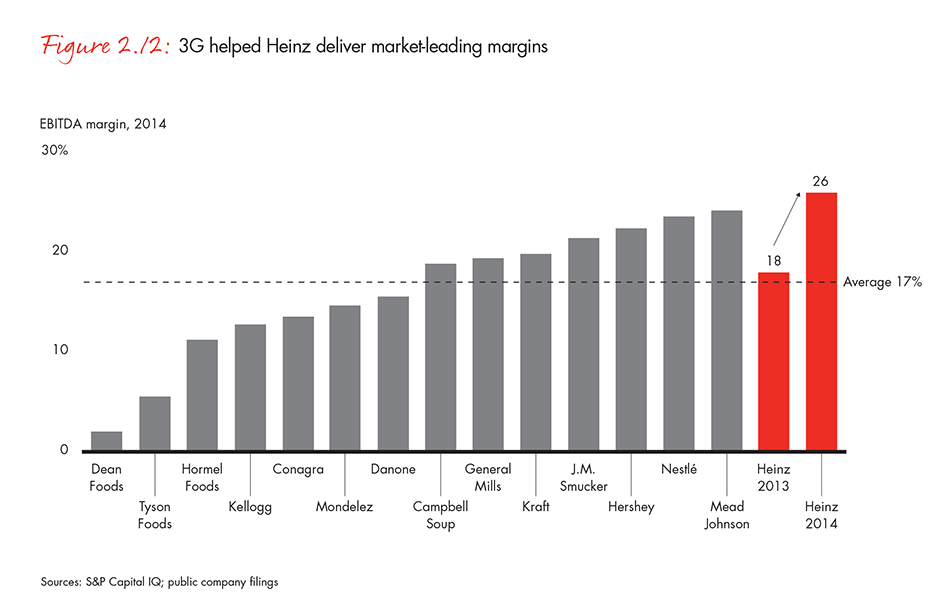

Other PE firms are running effective playbooks as well. Platinum Equity applies a trademarked M&A&O (mergers, acquisitions, operations) turnaround strategy that aims to create value through back-to-basics business strategies combined with operational guidance and resources. Platinum Equity focuses on operationally complex businesses with mission-critical products, established distribution networks and blue-chip customers.
Vista Equity Partners, which invests primarily in software and technology-enabled companies, applies a set of more than 50 proprietary standard operating procedures in areas such as product development, sales and marketing, customer support, professional services and general administration. Vista’s in-house consulting group works with investment professionals and portfolio company executives to apply those best practices. In a recent case, Vista sold TransFirst, a payment processor that Vista had acquired for $1.5 billion a little more than a year earlier, for $2.35 billion. PE Hub reported that Vista focused on building out TransFirst’s back-end settlement capability while enhancing its sales channels.
Vista’s playbook even extends to sourcing talent. In an interview with Columbia Business School, CEO Robert Smith discussed Vista’s finely tuned aptitude test, the origin of which dates back decades to a questionnaire developed by IBM. The test is given to candidates “to assess [their] technical and social skills and problem-solving abilities, and determine fit within specific job functions at a software company,” Smith said. Vista hires only people who score highly on the test, though the company also considers applicants’ emotional intelligence quotient and leadership abilities while paying less heed to their résumé or alma mater.
What unites distinctive playbook investors such as Vista and Platinum are the outsized financial returns they have managed to achieve. A whole cadre of firms now are engaged in writing their own playbooks to try to ensure repeated success.
Deliberate choices about where to play and how to win
Whether the investment thesis for a deal leans more toward cost takeout or revenue growth, defining the strategy to advance the business’s competitive position, economics and attractiveness at exit is essential. Some PE firms have neglected the discipline of strategy and instead revert to deploying whatever resources happen to be in-house—their procurement expert or sales-effectiveness whisperer. Yet without a sharp strategy and clarity on where to invest, their scarce resources might be invested inefficiently. Which high-potential markets or customer segments should the business emphasize? What capabilities need to stay strong or become even stronger to achieve the long-term vision? Where can the business afford to cut costs? Lacking a clear strategy, a PE fund could make short-term gains without seeing real progress on long-term value creation, which the next owners of the portfolio company will care about.
Strategy involves making choices in three broad areas. First, businesses must articulate an ambition or vision for the company that is both inspiring for employees and specific enough to inform strategic choices as opposed to vague, feel-good aspirations. Once the ambition is set, businesses must decide where to play—that is, determine what the business portfolio mix will look like in terms of geographic focus, customer segments, product lines and parts of the value chain. Then they must choose how to win by defining which management capabilities, operating capabilities and assets will be essential in supporting growth, and where the business can afford to be merely at parity (see Figure 2.13).
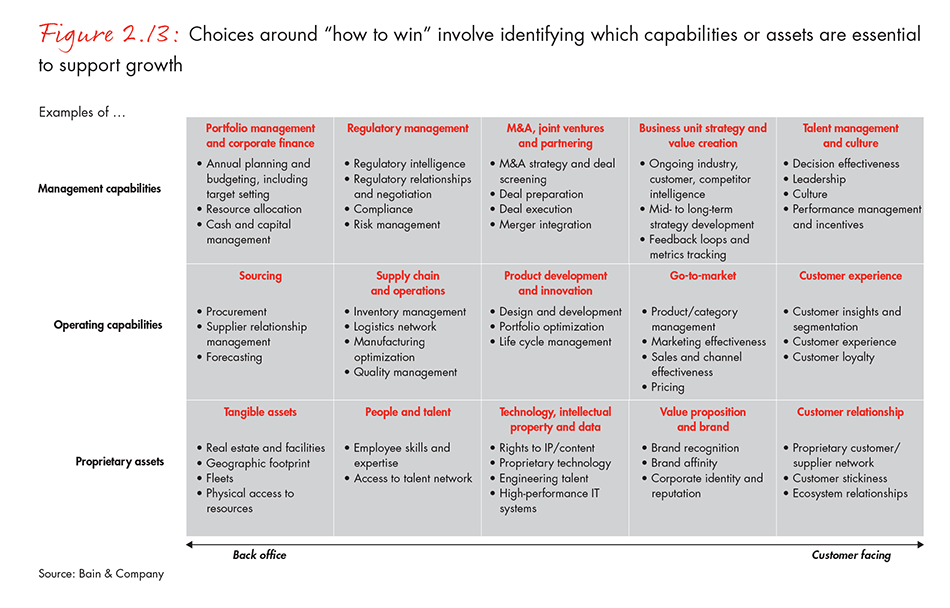

These sets of choices influence one another. Targeting affluent consumers, for example, often requires investing in product innovation and the overall experience surrounding the product, whereas targeting cost-conscious consumers requires superb execution in procurement and the supply chain. Making such choices helps a company identify where it can generate short-term savings without harming its ability to create a long-term competitive advantage.
Bain Capital and Hellman & Friedman, two firms with a history of successful value creation, joined forces to buy European monitored security provider Securitas Direct in 2011. The new owners recognized that continued growth of the company would require strong execution of a clear strategy. Securitas Direct’s how-to-win model focused on go-to-market execution (especially through salesforce effectiveness), on careful pricing by customer segment and, more broadly, on improving the customer experience in order to earn customer loyalty. Securitas Direct doubled down on investing in hiring, training and managing the salesforce, including more stringent productivity tracking and coaching. The company also raised the bar on customer service, implementing feedback loops from customers following service calls to ensure that customers were happy with the experience.
After starting to execute the growth strategy, Bain Capital and Hellman & Friedman turned to reducing costs. For instance, Securitas Direct worked with suppliers to improve product quality, thereby reducing customer service and maintenance costs, as well as cancellations. Based on this proven how-to-win model, Securitas Direct expanded into new countries and achieved the leading position in six of nine countries, with strong brand recognition and industry-leading customer loyalty.
Of course, there may be opportunities for a newly acquired company to save cash or increase revenue immediately, even before the strategy is fully baked. Ringing the cash register early de-risks the PE firm’s investment, and the extra cash flow can help fund the strategy.
Cost-reduction tiers for every playbook
While cost reduction alone is not sufficient in most cases, it does remain an integral aspect of any PE playbook. PE firms need to earn back what they paid for up front in anticipated cost opportunities, and that requires vigorous pursuit of cost savings after the deal closes—whether through specific cost plays such as general and administrative expense optimization, a comprehensive program that looks at costs across the enterprise or a clean-slate program to rebuild the cost structure from scratch. Here, the target company’s situation and investment thesis inform the scope and approach. We have observed three distinct approaches to cost reduction in PE playbooks that suit different circumstances.
- Targeted cost optimization is appropriate for companies with stable operations and an investment thesis focused primarily on growth. It uses benchmarks and reduction targets to examine what can be eliminated from current budgets. Companies target cost initiatives to select business units, geographies, functions or processes. Cost levers range from direct and indirect procurement to manufacturing optimization and supply chain management. Targeted tactics can address a particular area that has been mismanaged and that contains rich reserves of potential savings. Or they can support efforts that are easy to implement and that don’t fundamentally change current work processes.
- Sustained cost transformation makes sense for a company in which the entire cost structure requires an overhaul. Cost reductions link to the company’s strategy in order to separate good spending, which explicitly supports the strategy, from bad spending. The company might need to become the lowest-cost provider, protect margins in the face of falling average prices or widen a slim competitive advantage.
To permanently reduce costs, managers often need to change how work gets done. This could involve a range of measures: eliminating unnecessary or merely nice-to-have activities, reducing service levels where appropriate, automating low-value activities through digital processes, bundling and shifting volume to the best-value suppliers, and controlling internal demand for services.
Along with its broader scope and link to strategy, sustained cost transformation usually involves persuading employees to think and act differently, working with the grain of the organization (the processes and the culture) so that the changes will stick. This cultural shift comes through transparency of spending, strict accountability for packets of costs, and compensation and rewards linked to smart cost management.
An exhaustive search for cost opportunities characterized the due diligence of VNU, a global information and media company (now known as Nielsen), which was bought in 2006 by a consortium that included Blackstone, Ardian, AlpInvest, Carlyle, KKR, Hellman & Friedman and Thomas H. Lee. VNU was operating with a high cost base following years of M&A activity with little integration. The investors probed costs by business unit and by country. They sized up hundreds of millions of dollars in potential savings—above what the management team had identified—that could be achieved through tactics such as reducing organizational layers and giving managers broader spans of control, outsourcing IT to lower costs, and consolidating procurement across business units to get volume discounts. After the deal close, early actions by the new senior management team to start a sustained cost transformation realized the full amount of anticipated savings within 18 months.
True integration of the business units and a shift to manage VNU as one global business, along with close measurement and tracking of costs, ensured that the changes stuck and that costs squeezed out of one area didn’t migrate to another. The savings freed up cash to invest in faster-growing businesses, such as the social media-listening unit BuzzMetrics, which previously had been constrained by lack of funds. Despite being bought at a high price at the height of the boom and living through the subsequent downturn, this combination of taking out costs to refocus on higher-growth opportunities generated a sparkling success for the consortium.
- Accelerated transformation is a more urgent approach for companies that need to return to profitability or that must be transformed to ensure long-term survival. They must capture savings in the very near term, whether out of a need for pure survival or a burning ambition to rapidly fuel growth. Time is a precious currency in such situations. It can take months to identify, prove and build out the right transformation initiatives—particularly those that require changes to IT systems—and competitors continue to advance. PE activists know the virtues of moving quickly. They’re willing to test promising new ideas, assess them in short order, and scale them up or kill them quickly depending on the early results.
The clock was ticking at Tekni-Plex, a global packaging supplier, when Oaktree Capital Management and Avenue Capital took control in 2008. The company was on track to trip public debt covenants within six months due to lower-than-expected EBITDA. In short order, the leadership team at Tekni-Plex built fact bases about the key cost-saving opportunities and then launched a prioritized set of savings and cash-release initiatives to begin turning around performance. The initial priorities included optimizing the plant footprint, reining in freight and logistics costs, and rationalizing unprofitable products. These and other accelerated moves were monitored weekly. The team stabilized the situation at Tekni-Plex and put the business on track for profitable growth. In 2013, Tekni-Plex was sold for a reported $775 million to American Securities.
The accelerated time frame may not allow a PE firm time to coax along the entire management team, so the firm may initially need to apply transformation to the organization, not with the organization. While aggressive, the approach applies to both cost and revenue goals, and it takes care to incorporate strategy by projecting the future state of the market and the company’s desired position in that market. This in turn forces management to consider all the activities and conditions that must change in order for the company to survive— and thrive—in the future.
A bracing dose of zero-basing
In either sustained or accelerated transformation, a complete redesign of a company’s or business unit’s cost structure may be warranted. The organization could be deeply rooted in a past that differs dramatically from the future. Regulatory reform or other shocks in the industry could be stripping off profits. The business could have problems digesting several acquisitions, which adds layers of complexity to operations.
At that point, a PE firm would do well to take a blank-sheet approach to resource planning, reexamining all costs to determine which activities and resources are needed to compete effectively, how those activities could be handled more efficiently and which activities could be removed without gutting the strategy. This differs from traditional budgeting processes by examining all expenses for each new period, not just incremental expenditures in obvious areas. A zero-based approach puts the onus on managers to justify the costs that need to be kept—a subtle but powerful shift in perspective from what should be removed. This can be a one-time exercise, known as zero-based redesign, or a continuous capability within the organization called zero-based budgeting. Either way, the zero-based approach resets the cost structure to align with the strategy.
In practice, zero-based budgeting consists of a structured, activity-based cost system that recasts management accounts into different categories on which a PE firm could act. Take travel expenditures, which most business units and functions inside a company will incur. Instead of relying on each unit to manage its travel spending, a company can manage travel costs horizontally across the entire organization, forcing all units to begin at zero each year and justify every item of travel spending, to ensure they spend wisely and at the lowest possible price.
ATM provider NCR was dealing with stagnant margins and flat revenue as its core products were displaced, and the company needed fuel for new software and service development. After Blackstone bought a minority stake in NCR, the company deployed zero-based budgeting to ensure that every dollar of expense would serve the strategy, which relied heavily on R&D and technical innovation. NCR identified the major savings that it could capture within a year by eliminating wasteful spending, updating consumption policies and improving core business processes. To make the savings stick and change the culture, it developed global training sessions on the zero-based process and installed a cloud-based budgeting system for more distributed planning. NCR is on track to achieve a significant reduction in SG&A expenses in year one, along with additional in-year savings that both funded the program and accelerated strategic priorities.
A line of sight to growth
Whereas playbooks once focused mainly on cost, any asset today also needs a line of sight toward attaining sustainable and profitable growth in order to reach a successful exit. Growth requires a structured plan to maximize market share of the core products, pursue the most attractive adjacent markets and possibly buy businesses to tuck under.
How quickly a business can pivot from cost to growth varies. For a stable business in which the cost discipline resembles a routine health checkup, a PE firm can address both the bottom and top lines early on and at the same time. In cases of distress, the cost program should come first to stabilize the business before work begins to set it on a path to full potential.
Pursuing revenue growth means putting customers’ priorities first by listening to and taking action on customer feedback. Growth may involve concerted efforts in branding, marketing and sales, pricing and customer relationships, which usually require investing in supporting capabilities that range from customer insights to data analytics and rapid experimentation. The go-to-market model will be effective only when a company clearly defines its target customers and gets pricing, marketing and sales in sync. But you have to start somewhere, and PE playbooks tend to gravitate first to two areas ripe with opportunity that can be captured quickly: pricing and salesforce effectiveness.
Pricing affects profits more than any other factor, and yet many companies lack sophisticated pricing capabilities. As a result, weak accountability and discipline around price setting and discount management can cripple profitability. In business-to-business markets, many managers have accumulated beliefs that limit their pricing effectiveness. They believe that their products are commoditized so they must accept prevailing prices in the market. Or they rely too much on heavy, nonstandard discounts. In consumer industries, when managers change prices, a fundamental question sometimes goes unasked: Will customers notice and respond as expected? All too often, consumers don’t react as anticipated, so companies must use pricing tactics such as clear signage—not just the actual shelf price—to influence consumer perceptions.
Turning to the sales arena, new portfolio companies frequently can improve salesforce productivity through a few tactics: better definition of the most profitable and highest-potential target accounts, pragmatic plans for top accounts, disciplined tracking to measure progress, and a compensation system that motivates the right behaviors. Companies must commit their best sales resources against the biggest opportunities. Whether the sales representatives are hunting for new customers or farming for opportunities within current accounts, they are ambassadors of the brand. They need to be engaged and excited, and compensation and incentives should align that energy with the company’s goals.
In pricing, sales and other areas, PE firms can add huge value by systematically investing in the capabilities and processes that lead to profitable growth. The specific investment depends on the company’s particular strategy.
Therefore, a PE firm’s playbook must be able to adapt to that strategy and the company’s overall situation. Exactly what set of actions a PE firm will codify and incorporate depends on its strategy and how it has defined its sweet spot for ongoing success. All PE firms want to create value as quickly as possible—to grow revenue and take out cost—and a strong playbook helps to accomplish that.
Section 3. PE firms come to grips with high prices
As general partners (GPs) and limited partners (LPs) contemplate moves for the coming year and their longer-term strategy, persistently high asset prices are playing a larger role in their thinking. Rising valuations have been fueled by the enormous expansion of financial assets building up in the global economy over several decades. This capital superabundance stems from the confluence of financial engineering, high-speed computing and a loosening of financial services regulations that supplanted the post–World War II fixed exchange-rate system with a system allowing rapid expansion of capital around the globe. The resulting growth of financial assets has been prodigious and relentless.
Asset prices will remain high as investors of all types wielding record amounts of capital continue to bid up acquisition multiples to acquire assets. Plentiful low-cost debt in the hands of yield-hungry creditors merely adds upward pressure on prices and ensures they will stay high. The expansion of financial assets is an enduring feature that investors know they need to reckon with, spurring a variety of responses from PE firms and injecting a large dose of uncertainty into the industry.
No relief in sight
The accretion of PE dry powder to new record levels is not expected to slow anytime soon. Distributions to LPs will continue to outpace capital calls in the future, and investor demand for the asset class shows no sign of waning. This swelling pool of capital is chasing a set of deal opportunities that has not expanded as rapidly. Indeed, since 2012, the count of global buyout deals decreased at a rate of 9% annually, while deal value rose at a 6% compound annual growth rate.
The ascent of shadow capital, in both scale and scope, has exacerbated the situation. Forms of shadow capital range from separate accounts to coinvestment and cosponsorship to solo direct investments. Precise totals of investments in these four categories don’t exist, but Bain estimates that coinvestment (the largest form of shadow capital) represents 10% to 12% of traditional fund-raising and that shadow capital in all its forms combined could be as much as 15% to 20%. What’s clear is that shadow capital is large, growing and here to stay.
Shadow capital can offer substantial benefits to LPs, starting with lower fees and carry. Private equity remains an expensive asset class, though given its higher returns profile relative to other asset classes, most investors are willing to pay those fees.
According to Cambridge Associates, the average gap between gross and net internal rates of return for PE funds has been around 600 basis points since the mid-1980s (see Figure 3.1). Besides lower costs, the allure of shadow capital is the greater control it gives LPs over how they put their money to work. They can better calibrate timing of investments and exposure to industries or geographies.
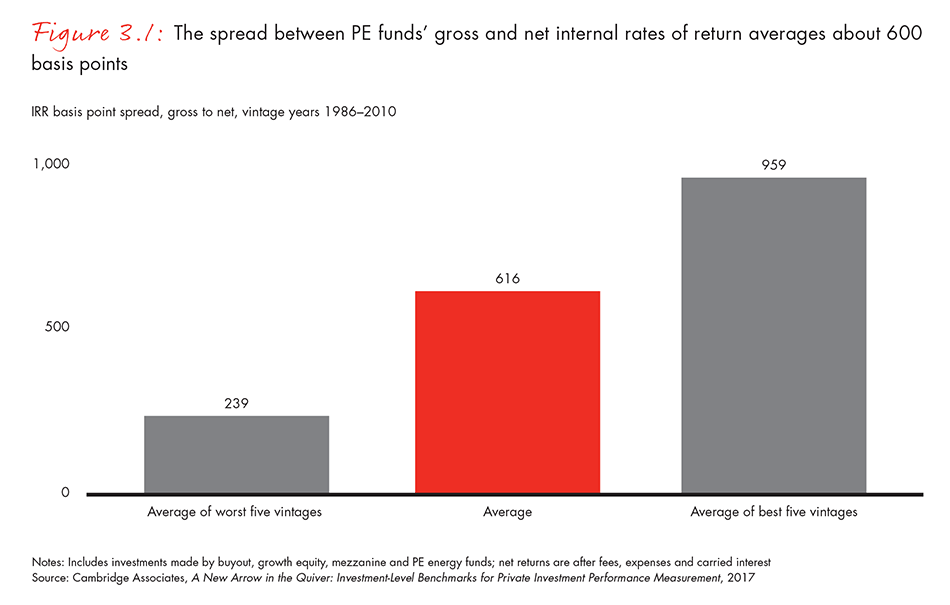

But shadow capital pours more fuel on the fire by further intensifying competition for assets. That competition, combined with the lower cost of shadow equity and direct LPs’ traditional preference for middle-of-the-fairway deals—companies with strong management, healthy financials and that operate in attractive industries—has been driving down returns of such deals.
Entering risky territory off the fairway
As a result, GPs who aspire to generate the strong returns that a “2-and-20” model demands will have to take on more risk or get more creative in putting money to work. The standard formula for GPs cannot accommodate the prices paid in the middle of the fairway. PE funds are getting pushed into the rough and the sand traps, where the higher-risk deals live. Whether it is underwriting more growth or tackling tricky turnarounds, GPs need to sharpen their pencils to determine what risks they are willing to underwrite and, at the same time, build stronger capabilities to manage that risk.
Some PE firms have gone even further off the beaten path to close high-potential deals. Silver Lake teamed up with Michael Dell, for instance, to piece together an offer for Dell that included cash and equity contributed by Mr. Dell, equity from Silver Lake’s buyout fund and coinvestments, along with rollover and newly issued debt.
Creative arrangements might entail partnering more with corporate buyers to find companies that suit the needs of both parties. For example, GI Partners teamed up with Allscripts Healthcare Solutions to buy healthcare software and services provider Netsmart Technologies from Genstar Capital for $950 million. Allscripts merged its smaller rival business, Allscripts Homecare, into the joint venture.
Deal structuring can get more creative as well by, for instance, offering sellers the opportunity to roll over some of their equity into the transaction. HGGC, a US middle-market PE firm, requires all sellers—whether large sponsors, a founder or a management team—to reinvest. “They are less focused on the highest price because they’re not leaving,” CEO Rich Lawson told PE Hub. This has helped HGGC to pay lower deal multiples, on average, than other firms.
Establishing a joint venture rather than making an outright purchase of an asset holds out another creative approach to deal making. Tenet Healthcare paid $425 million to buy 50.1% of United Surgical Partners, a portfolio company of Welsh, Carson, Anderson & Stowe, in a joint venture. The deal also gave Tenet a path to full ownership over five years through a put/call structure. Having a strategic coinvestor provides a built-in exit strategy when the timing is right.
If you can’t beat them, join them
Some GPs will no doubt continue to participate in middle-of-the-fairway deals. For them, success may hinge on working more frequently in concert with shadow capital rather than competing against it.
Cosponsorship and solo direct investing are limited to a small number of institutions with the requisite heft and ability to mount their own programs—notably, big pension funds in Canada, sovereign wealth funds in the Middle East and Asia, and a few large European family offices. The Canada Pension Plan Investment Board (CPPIB) illustrates the trajectory of these influential investors. CPPIB started its direct investing program in the mid-2000s. By 2016, it had scaled up the direct PE program to a net asset value of C$16.6 billion, comprising 29% of its total PE investment (see Figure 3.2).
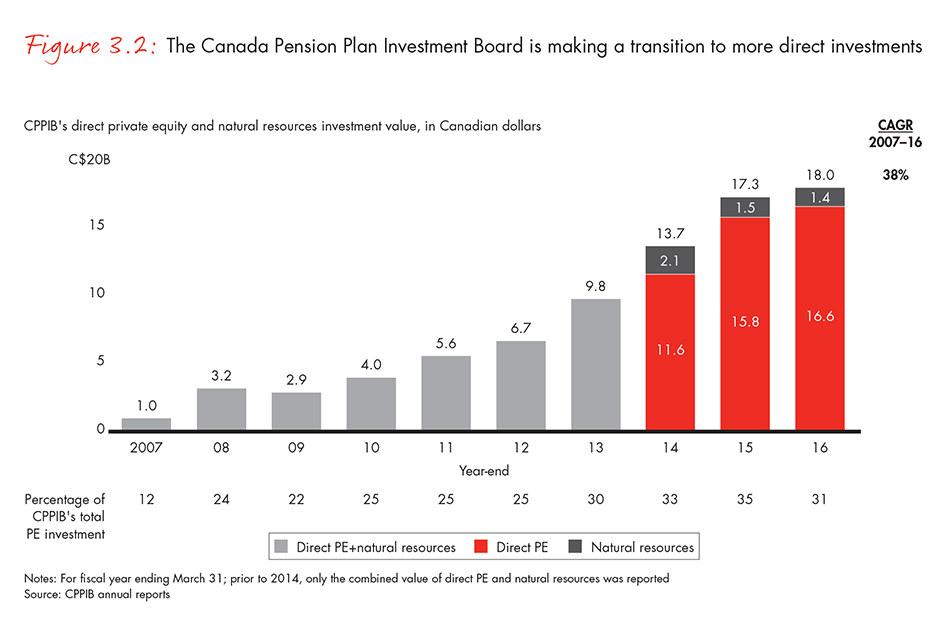

Often these institutions prefer to work alongside GPs rather than going it alone. Cosponsored investments that pair GPs and LPs can employ a mutually beneficial division of labor, serving both parties’ interests. The GP gains access to deep pools of cash from sophisticated investors. The LP gets to leverage and learn from the expert guidance of a GP seasoned in the disciplines of PE due diligence, negotiation and post-acquisition value creation.
CPPIB, for instance, typically invests alongside existing fund partners and opportunistically pursues deals on its own that are not accessible through cosponsorships. CPPIB and European PE firm Cinven partnered to buy Hotelbeds Group, a Spain-based global provider of travel services, for €1.2 billion.
Similarly, Singapore’s GIC teamed up with Carlyle to buy information management system provider Veritas from Symantec. Buyout funds and institutional investors joined to buy LeasePlan, a fleet management company; the consortium consisted of two GPs (Goldman Sachs and TDR Capital) and four institutional investors (Abu Dhabi Investment Authority, Danish pension fund ATP, GIC and Dutch pension fund PGGM).
No more than 100 investors have the scale and capabilities to show up at auction as a cosponsor or solo direct investor, Bain estimates, but when they do show up, they can jolt the deal-auction process. In the absence of fees and carry, direct investors can afford to pay a higher price and still achieve their target returns. When institutional investors and GPs team up, this situation is less of a problem, because deal models are underwritten on terms satisfactory to the GPs. In the rarer instances in which institutional investors go it alone, the resulting higher prices make it harder for GPs to buy high-quality assets and still generate the returns that LPs expect from their 2-and-20 funds.
New core funds try to expand LPs’ options
In the face of too much capital chasing too few deals and persistently high asset prices, a small but growing number of PE firms are defining a new product designed to expand the potential universe of buyouts. Altas Partners, Blackstone, Carlyle and CVC Capital Partners have all launched so-called core funds, raising almost $20 billion in capital combined. They aim to include investments with a risk-return horizon in between 2-and-20 buyout funds and infrastructure funds, raising patient capital to buy assets that will deliver predictable, attractive net returns at appropriate prices.
Blackstone Core Equity Partners, for instance, is raising $5 billion in a fund with a 20-year lifespan that can hold individual investments for twice as long as the typical 3- to 5-year buyout holding period. It will back companies that are larger, more established and financed with less leverage than most buyout targets, and aim for an annualized net return of 15%—less than the target for Blackstone’s $18 billion flagship buyout fund. It will charge half the standard incentive fee, taking just 10% in carry.
Carlyle Global Partners raised $3.6 billion for a long-hold fund, also with a lifespan of up to 20 years. The fund looks for family-owned businesses and companies that need capital to build themselves over an extended period. It charges a reported 1% management fee and 15% carry and seeks to at least double the value of investments over time while targeting somewhat lower annual returns than its main buyout fund.
The ranks of funds that offer such products could swell. Unlike the finite set of institutional investors that can build large-scale direct investment programs, virtually any PE firm can initiate long-hold funds. This rising pool of capital thus could fundamentally reshape the 2-and-20 equation.
Core funds hold promise for PE firms that can identify which assets will benefit from longer holding periods and then figure out the right balance of risk, return, fees and carry. The key challenge that fund managers face here is articulating the asset characteristics that would fit a 1-and-12 fund but not a conventional 2-and-20 fund. Is there a unique world between infrastructure fund returns and conventional fund returns that these products can inhabit and thus expand the market for buyouts?
The few deals that core funds have done to date are too recent to provide a definitive answer. Carlyle, for instance, teamed up with Centre Lane Partners to combine two candle and home fragrance companies into Luminex Home Décor & Fragrance. It has also invested in a provider of corporate and private aircraft financing and an operator of specialist hospitals in Germany. CVC, meanwhile, has purchased major stakes in UK roadside-assistance operator RAC Group and UK highway service station operator Moto Hospitality.
GPs will need to be able to dial in on target returns. How well they define this realm between fully priced buyout and infrastructure funds, and then deliver the target returns, will determine the attractiveness of this new product. If core funds grow dramatically, they could affect the economics of the entire industry.
Forward-looking GPs have already begun to examine their appetite for greater risk and their ability to deliver on that. Others are testing more creative deal structures to shore up returns against the flood of capital chasing deals that many investors perceive as safe and attractive. Those who continue to pursue middle-of-the-fairway deals should be looking to build strong ties with the handful of large LPs doing these deals. Some are experimenting with the new sub-asset class of core funds, with the jury still out on performance and sustainability. The PE ecosystem has grown more diverse, and this next stage of natural selection will favor a different set of fund traits than in the past.